SolusVM Extended VPS For WHMCS
(→Dynamic Server Resources Setup With Configurable Options) |
(→Upgrade Guide) |
||
| (148 intermediate revisions by 11 users not shown) | |||
| Line 2: | Line 2: | ||
<meta name="description" content="ModulesGarden Wiki Contains All The Information You Need About The SolusVM Extended VPS For WHMCS Module."></meta> | <meta name="description" content="ModulesGarden Wiki Contains All The Information You Need About The SolusVM Extended VPS For WHMCS Module."></meta> | ||
| − | =About [ | + | =About [https://www.modulesgarden.com/products/whmcs/solusvm-extended-vps SolusVM Extended VPS For WHMCS] = |
{| | {| | ||
| − | |style="padding: 10px 0px 10px 0px;"|'''SolusVM Extended VPS For WHMCS''' | + | |style="padding: 10px 0px 10px 0px;"|'''SolusVM Extended VPS For WHMCS''' will allow you to automatically provision and manage virtual servers in your WHMCS.<br/> |
| − | + | You will be able to set up ready products in your system through the use of various configurable options.<br/> | |
| − | + | Your clients will be able to perform all crucial actions on their servers remotely, access different consoles, view graphs and more. | |
|} | |} | ||
| − | *'''Features | + | <!-- fixed --> |
| + | *'''Admin Area Features:''' | ||
{| | {| | ||
| − | |style="padding: 10px 0px 0px 30px;"|✔ | + | |style="padding: 10px 0px 0px 30px;"|✔ Create/Suspend/Unsuspend/Terminate Server |
|} | |} | ||
{| | {| | ||
| − | |style="padding: 0px 0px 0px 30px;"|✔ | + | |style="padding: 0px 0px 0px 30px;"|✔ Create User Account |
|} | |} | ||
{| | {| | ||
| − | |style="padding: 0px 0px 0px 30px;"|✔ | + | |style="padding: 0px 0px 0px 30px;"|✔ Change Package - Supports Configurable Options |
|} | |} | ||
{| | {| | ||
| − | |style="padding: 0px 0px 0px 30px;"|✔ | + | |style="padding: 0px 0px 0px 30px;"|✔ Change Password Of Account |
|} | |} | ||
{| | {| | ||
| − | |style="padding: 0px 0px | + | |style="padding: 0px 0px 0px 30px;"|✔ Boot/Reboot/Shutdown Server |
|} | |} | ||
| − | |||
{| | {| | ||
| − | |style="padding: | + | |style="padding: 0px 0px 0px 30px;"|✔ Toggle TUN/TAP And PAE |
|} | |} | ||
{| | {| | ||
| − | |style="padding: 0px 0px 0px 30px;"|✔ | + | |style="padding: 0px 0px 0px 30px;"|✔ Reconfigure Network |
|} | |} | ||
{| | {| | ||
| − | |style="padding: 0px 0px 0px 30px;"|✔ | + | |style="padding: 0px 0px 0px 30px;"|✔ Rebuild Server |
|} | |} | ||
{| | {| | ||
| − | |style="padding: 0px 0px 0px 30px;"|✔ | + | |style="padding: 0px 0px 0px 30px;"|✔ Change Password: Root, Client, SSH Console, VNC Console |
|} | |} | ||
{| | {| | ||
| − | |style="padding: 0px 0px 0px 30px;"|✔ | + | |style="padding: 0px 0px 0px 30px;"|✔ Mount/Unmount ISO |
|} | |} | ||
{| | {| | ||
| − | |style="padding: 0px 0px 0px 30px;"|✔ Boot | + | |style="padding: 0px 0px 0px 30px;"|✔ Change Boot Order |
|} | |} | ||
{| | {| | ||
| − | |style="padding: 0px 0px 0px 30px;"|✔ | + | |style="padding: 0px 0px 0px 30px;"|✔ View Server Status |
|} | |} | ||
{| | {| | ||
| − | |style="padding: 0px 0px 0px 30px;"|✔ | + | |style="padding: 0px 0px 0px 30px;"|✔ View Graphs: Traffic, Load, Memory |
|} | |} | ||
{| | {| | ||
| − | |style="padding: 0px 0px 0px 30px;"|✔ | + | |style="padding: 0px 0px 0px 30px;"|✔ Change IP Addresses |
|} | |} | ||
{| | {| | ||
| − | |style="padding: 0px 0px 0px 30px;"|✔ | + | |style="padding: 0px 0px 0px 30px;"|✔ Define Product Resource: |
|} | |} | ||
{| | {| | ||
| − | |style="padding: 0px 0px 0px | + | |style="padding: 0px 0px 0px 45px;"|✔ Dynamically - Using Configurable Options |
|} | |} | ||
{| | {| | ||
| − | |style="padding: 0px 0px 0px | + | |style="padding: 0px 0px 0px 45px;"|✔ Statically - Using 'Module Settings' Fields |
|} | |} | ||
{| | {| | ||
| − | |style="padding: 0px 0px 0px 30px;"|✔ | + | |style="padding: 0px 0px 0px 30px;"|✔ Configure Client Area Features Per Product |
|} | |} | ||
{| | {| | ||
| − | |style="padding: 0px 0px 0px 30px;"|✔ OS Templates | + | |style="padding: 0px 0px 0px 30px;"|✔ Define OS Templates Available For Rebuild |
|} | |} | ||
{| | {| | ||
| − | |style="padding: 0px 0px 0px 30px;"|✔ | + | |style="padding: 0px 0px 0px 30px;"|✔ Allow To Rebuild Server On Purchased OS Only |
|} | |} | ||
{| | {| | ||
| − | |style="padding: 0px 0px 0px 30px;"|✔ | + | |style="padding: 0px 0px 0px 30px;"|✔ Set Rebuild Limit |
|} | |} | ||
{| | {| | ||
| − | |style="padding: 0px 0px | + | |style="padding: 0px 0px 0px 30px;"|✔ Select Kernels For Rescue Mode |
| + | |} | ||
| + | {| | ||
| + | |style="padding: 0px 0px 0px 30px;"|✔ Configure Friendly Names For OS Templates And Nodes | ||
| + | |} | ||
| + | {| | ||
| + | |style="padding: 0px 0px 0px 30px;"|✔ Create New SolusVM User For Each VPS Ordered By Client | ||
| + | |} | ||
| + | {| | ||
| + | |style="padding: 0px 0px 0px 30px;"|✔ Toggle Root Password Storing In System Database | ||
| + | |} | ||
| + | {| | ||
| + | |style="padding: 0px 0px 0px 30px;"|✔ Toggle Root Password Change After Server Creation | ||
| + | |} | ||
| + | {| | ||
| + | |style="padding: 0px 0px 0px 30px;"|✔ View Decoded Server Password | ||
| + | |} | ||
| + | {| | ||
| + | |style="padding: 0px 0px 10px 30px;"|✔ Run API Connection Test | ||
|} | |} | ||
*'''Client Area Features:''' | *'''Client Area Features:''' | ||
{| | {| | ||
| − | |style="padding: 10px 0px 0px 30px;"|✔ | + | |style="padding: 10px 0px 0px 30px;"|✔ View Server Details And Status |
|} | |} | ||
{| | {| | ||
| − | |style="padding: 0px 0px 0px 30px;"|✔ Rebuild Server | + | |style="padding: 0px 0px 0px 30px;"|✔ Boot/Reboot/Shutdown/Rebuild/Delete Server |
|} | |} | ||
{| | {| | ||
| − | |style="padding: 0px 0px 0px 30px;"|✔ SSH Console | + | |style="padding: 0px 0px 0px 30px;"|✔ Access SSH Console - OpenVZ And Xen Only |
|} | |} | ||
{| | {| | ||
| − | |style="padding: 0px 0px 0px 30px;"|✔ VNC Console | + | |style="padding: 0px 0px 0px 30px;"|✔ Access VNC Console - KVM And Xen HVM Only |
|} | |} | ||
{| | {| | ||
| − | |style="padding: 0px 0px 0px 30px;"|✔ | + | |style="padding: 0px 0px 0px 30px;"|✔ Access NoVNC HTML5 Console - KVM And Xen HVM Only |
|} | |} | ||
{| | {| | ||
| − | |style="padding: 0px 0px 0px 30px;"|✔ | + | |style="padding: 0px 0px 0px 30px;"|✔ Access HTML5 Serial Console - OpenVZ And Xen Only |
|} | |} | ||
{| | {| | ||
| − | |style="padding: 0px 0px 0px 30px;"|✔ | + | |style="padding: 0px 0px 0px 30px;"|✔ Log In To Control Panel |
|} | |} | ||
{| | {| | ||
| − | |style="padding: 0px 0px 0px 30px;"|✔ | + | |style="padding: 0px 0px 0px 30px;"|✔ Toggle TUN/TAP And PAE |
|} | |} | ||
{| | {| | ||
| − | |style="padding: 0px 0px 0px 30px;"|✔ | + | |style="padding: 0px 0px 0px 30px;"|✔ Toggle PXE (Preboot Execution Environment) |
|} | |} | ||
{| | {| | ||
| − | |style="padding: 0px 0px 0px 30px;"|✔ | + | |style="padding: 0px 0px 0px 30px;"|✔ Toggle Rescue Mode With Chosen Kernel |
|} | |} | ||
{| | {| | ||
| − | |style="padding: 0px 0px 0px 30px;"|✔ | + | |style="padding: 0px 0px 0px 30px;"|✔ Reconfigure Network |
|} | |} | ||
{| | {| | ||
| − | |style="padding: 0px 0px 0px 30px;"|✔ | + | |style="padding: 0px 0px 0px 30px;"|✔ Change Passwords: Root, Client, SSH Console And VNC Console |
|} | |} | ||
{| | {| | ||
| − | |style="padding: 0px 0px 0px 30px;"|✔ | + | |style="padding: 0px 0px 0px 30px;"|✔ Change Hostname |
|} | |} | ||
{| | {| | ||
| − | |style="padding: 0px 0px | + | |style="padding: 0px 0px 0px 30px;"|✔ Change IP Addresses |
|} | |} | ||
| − | |||
{| | {| | ||
| − | |style="padding: | + | |style="padding: 0px 0px 0px 30px;"|✔ Mount/Unmount ISO |
|} | |} | ||
{| | {| | ||
| − | |style="padding: 0px 0px 0px 30px;"|✔ | + | |style="padding: 0px 0px 0px 30px;"|✔ Change Boot Order |
|} | |} | ||
{| | {| | ||
| − | |style="padding: 0px 0px 0px 30px;"|✔ | + | |style="padding: 0px 0px 0px 30px;"|✔ View Graphs: Traffic, Load, Memory |
|} | |} | ||
{| | {| | ||
| − | |style="padding: 0px 0px 0px 30px;"|✔ | + | |style="padding: 0px 0px 0px 30px;"|✔ Send Email Templates After Creation Of Server Based On Its Type |
|} | |} | ||
{| | {| | ||
| − | |style="padding: 0px 0px | + | |style="padding: 0px 0px 0px 30px;"|✔ Choose Server Resources While Ordering And Upgrade/Downgrade Them Freely |
|} | |} | ||
| − | + | {| | |
| − | *''' | + | |style="padding: 0px 0px 10px 30px;"|✔ Choose SolusVM Username When Ordering New Product |
| + | |} | ||
| + | *'''Configurable Options:''' | ||
{| | {| | ||
|style="padding: 10px 0px 0px 30px;"|✔ Operating System | |style="padding: 10px 0px 0px 30px;"|✔ Operating System | ||
| Line 145: | Line 164: | ||
{| | {| | ||
|style="padding: 0px 0px 0px 30px;"|✔ Disk Space | |style="padding: 0px 0px 0px 30px;"|✔ Disk Space | ||
| + | |} | ||
| + | {| | ||
| + | |style="padding: 0px 0px 0px 30px;"|✔ Secondary Disk Size | ||
|} | |} | ||
{| | {| | ||
| Line 153: | Line 175: | ||
|} | |} | ||
{| | {| | ||
| − | |style="padding: 0px 0px 0px 30px;"|✔ Extra | + | |style="padding: 0px 0px 0px 30px;"|✔ Extra IPv4 Address |
|} | |} | ||
{| | {| | ||
| Line 159: | Line 181: | ||
|} | |} | ||
{| | {| | ||
| − | |style="padding: 0px 0px | + | |style="padding: 0px 0px 0px 30px;"|✔ Location |
| + | |} | ||
| + | {| | ||
| + | |style="padding: 0px 0px 0px 30px;"|✔ ISO Image | ||
| + | |} | ||
| + | {| | ||
| + | |style="padding: 0px 0px 0px 30px;"|✔ Network Speed | ||
| + | |} | ||
| + | {| | ||
| + | |style="padding: 0px 0px 10px 30px;"|✔ Rebuild Limit | ||
| + | |} | ||
| + | |||
| + | *'''General Info:''' | ||
| + | {| | ||
| + | |style="padding: 10px 0px 0px 30px;"|✔ Supports OpenVZ, Xen And KVM Virtualization | ||
| + | |} | ||
| + | {| | ||
| + | |style="padding: 0px 0px 0px 30px;"|✔ Integrated With <u>DNS Manager For WHMCS</u> - Supports PowerDNS [https://www.modulesgarden.com/products/whmcs/dns-manager/features (read more)] | ||
| + | |} | ||
| + | {| | ||
| + | |style="padding: 0px 0px 0px 30px;"|✔ Integrated With <u>Advanced Billing For WHMCS</u> - Actual Server Resource Usage Billing [https://www.modulesgarden.com/products/whmcs/advanced-billing/features (read more)] | ||
| + | |} | ||
| + | {| | ||
| + | |style="padding: 0px 0px 0px 30px;"|✔ Integrated With <u>IP Manager For WHMCS</u> - Complete Management of IP Pools [https://www.modulesgarden.com/products/whmcs/ip-manager/features (read more)] | ||
| + | |} | ||
| + | {| | ||
| + | |style="padding: 0px 0px 0px 30px;"|✔ Integrated With <u>Server Allocator For WHMCS</u> - Automatic Assignment Of Most Suitable Servers To Products [https://www.modulesgarden.com/products/whmcs/server-allocator (read more)] | ||
| + | |} | ||
| + | {| | ||
| + | |style="padding: 0px 0px 0px 30px;"|✔ Multi-Language Support | ||
| + | |} | ||
| + | {| | ||
| + | |style="padding: 0px 0px 0px 30px;"|✔ Supports SolusVM 1.0 (Compatibility With SolusVM 2 Coming Soon) | ||
| + | |} | ||
| + | {| | ||
| + | |style="padding: 0px 0px 0px 30px;"|✔ Supports PHP 8.1 Back To PHP 7.4 | ||
| + | |} | ||
| + | {| | ||
| + | |style="padding: 0px 0px 0px 30px;"|✔ Supports WHMCS Themes "Six" And "Twenty-One" | ||
| + | |} | ||
| + | {| | ||
| + | |style="padding: 0px 0px 0px 30px;"|✔ Supports WHMCS V8.8 Back To WHMCS V8.6 | ||
| + | |} | ||
| + | {| | ||
| + | |style="padding: 0px 0px 0px 30px;"|✔ Requires ionCube Loader V12 Or Later | ||
| + | |} | ||
| + | {| | ||
| + | |style="padding: 0px 0px 30px 30px;"|✔ Easy [https://www.docs.modulesgarden.com/How_To_Upgrade_WHMCS_Module Module Upgrade] To [https://www.modulesgarden.com/products/whmcs/solusvm-extended-vps#open-source-version Open Source Version] | ||
|} | |} | ||
=Installation and Configuration= | =Installation and Configuration= | ||
{| | {| | ||
| − | |style="padding: 10px 0px | + | |style="padding: 10px 0px 15px 15px;"|'''In this tutorial we will show you how to successfully install [https://www.modulesgarden.com/products/whmcs/solusvm-extended-vps SolusVM Extended VPS For WHMCS.]'''<br/> |
We will guide you step by step through the whole installation and configuration process. | We will guide you step by step through the whole installation and configuration process. | ||
|} | |} | ||
{| | {| | ||
| − | |style="padding: 0px 0px 20px 15px;"|'''1. Log in to | + | |style="padding: 0px 0px 20px 15px;"|'''1. Log in to our client area and download the module.''' |
|} | |} | ||
{| | {| | ||
| Line 174: | Line 243: | ||
|} | |} | ||
{| | {| | ||
| − | |style="padding: 0px 0px 15px 15px;"|'''2. | + | |style="padding: 0px 0px 15px 15px;"|'''2. In the downloaded file you might find one or two packages that support different PHP versions.'''<br/> |
| − | + | In the most recent versions of the module, you will find only one package that supports PHP 7.2 and later.<br/> <!-- If you need a package for the previous versions of PHP, please [https://www.modulesgarden.com/support/ticket/general-support contact our support]. --> | |
| + | |} | ||
| + | {| | ||
| + | |style="padding: 0px 0px 20px 25px;"|[[File:PHP72_74.png]] | ||
| + | |} | ||
| + | {| | ||
| + | |style="padding: 0px 0px 15px 15px;"|'''Previous updates of the module may contain two packages dedicated to various PHP versions.'''<br/> | ||
| + | The first one that supports PHP 5.6 up to PHP 7.1, and the second one addressed to PHP 7.2 up to PHP 7.4.<br/> | ||
| + | '''''Note:''' Keep in mind that PHP versions 5.6 up to 7.1 are no longer officially supported and their security issues are not fixed or released any more. Find more info [http://php.net/supported-versions.php here].'' | ||
| + | |} | ||
| + | {| | ||
| + | |style="padding: 0px 0px 20px 25px;"|[[File:PHP56_74.png]] | ||
| + | |} | ||
| + | {| | ||
| + | |style="padding: 0px 0px 10px 15px;"| <!-- '' '''Important''': This situation does not affect [https://www.modulesgarden.com/products/whmcs/solusvm-extended-vps#open-source-version '''the open source version'''] of this module which can be applied to any PHP from version 5.6 and later.''<br/>'' --> '''Note''': You can check the current PHP version in your WHMCS. To do so, proceed to ''' 'Utilities' → 'System' → 'PHP Info'.''' | ||
| + | |} | ||
| + | {| | ||
| + | |style="padding: 0px 0px 15px 15px;"|'''3. Extract the package and upload its content into the main WHMCS directory. <br/> | ||
| + | The content of the package to upload should look like this. | ||
|} | |} | ||
{| | {| | ||
| − | |style="padding: 0px 0px 20px 25px;"|[[File: | + | |style="padding: 0px 0px 20px 25px;"|[[File:SV2_1.png]] |
|} | |} | ||
{| | {| | ||
| − | |style="padding: 0px 0px 15px 15px;"|''' | + | |style="padding: 0px 0px 15px 15px;"|'''4. When you install SolusVM Extended VPS For WHMCS for the first time you have to rename '' 'license_RENAME.php' '' file.'''<br/> |
| − | File is located | + | File is located in '' 'modules/servers/solusvmExtendedVPS/license_RENAME.php'. '' Rename it from '' 'license_RENAME.php' '' to '' 'license.php'.'' |
|} | |} | ||
{| | {| | ||
| Line 188: | Line 275: | ||
|} | |} | ||
{| | {| | ||
| − | |style="padding: 0px 0px 15px 15px;"|''' | + | |style="padding: 0px 0px 15px 15px;"|'''5. In order to configure your license key, you have to edit a previously renamed '' 'license.php' '' file.'''<br/> |
| − | Enter your license key between quotation marks as presented on the following screen. You can find your license key | + | Enter your license key between quotation marks as presented on the following screen. You can find your license key in our client area → '' 'My Products'.'' |
|} | |} | ||
{| | {| | ||
| Line 196: | Line 283: | ||
==Configuration of API Access== | ==Configuration of API Access== | ||
{| | {| | ||
| − | |style="padding: 10px 0px 15px 15px;"|''' | + | |style="padding: 10px 0px 15px 15px;"|'''6. Now, we will show you how to configure a new product.'''<br/> |
| − | + | Firstly, log in to your SolusVM admin area, go to '' 'Configuration' → 'API Access' '' and press '' 'Add API User'.'' | |
|} | |} | ||
{| | {| | ||
| Line 203: | Line 290: | ||
|} | |} | ||
{| | {| | ||
| − | |style="padding: 0px 0px 20px 15px;"|''' | + | |style="padding: 0px 0px 20px 15px;"|'''7. Fill in your IP address and once again click on '' 'Add API User' '' button.''' |
|} | |} | ||
{| | {| | ||
| Line 210: | Line 297: | ||
==Configuration of Server== | ==Configuration of Server== | ||
{| | {| | ||
| − | |style="padding: 10px 0px 15px 15px;"|''' | + | |style="padding: 10px 0px 15px 15px;"|'''8. Now, log in to your WHMCS admin area and proceed to '' 'System Settings' → 'Servers'.'''''<br/> |
| − | Afterwards, press '' 'Add New Server' '' | + | Afterwards, press '' 'Add New Server'.'' |
|} | |} | ||
{| | {| | ||
| Line 217: | Line 304: | ||
|} | |} | ||
{| | {| | ||
| − | |style="padding: 0px 0px 15px 15px;"|''' | + | |style="padding: 0px 0px 15px 15px;"|'''9. Enter your server name and IP address.'''<br/> |
| − | + | Choose '' 'SolusvmExtendedVPS' '' from a dropdown menu and provide: | |
| − | + | *'''Username''' - fill in with API User ID | |
| − | + | *'''Password''' - fill in with API User Key | |
| + | Check if your server use SSL connection and optionally provide a custom port (by defualt the '' '5656' '' is used). <br/> | ||
| + | Press '' 'Save Changes' '' when ready. | ||
|} | |} | ||
{| | {| | ||
| Line 226: | Line 315: | ||
|} | |} | ||
{| | {| | ||
| − | |style="padding: 0px 0px 15px 15px;"|''' | + | |style="padding: 0px 0px 15px 15px;"|'''10. After configuring your server correctly, you are going to see the following screen.'''<br/> |
| − | Test your connection and API key through pressing | + | Test your connection and API key through pressing '' 'Test Connection'.''<br/> |
| − | Now, you need to create a new group for your server. For that purpose press '' 'Create New Group' '' | + | Now, you need to create a new group for your server. For that purpose press '' 'Create New Group'.'' |
|} | |} | ||
{| | {| | ||
| Line 234: | Line 323: | ||
|} | |} | ||
{| | {| | ||
| − | |style="padding: 0px 0px | + | |style="padding: 0px 0px 15px 15px;"|'''11. Fill in name, choose a previously created server and press '' 'Add'.'' '''<br/> |
| + | Confirm by clicking on '' 'Save Changes'.'' | ||
|} | |} | ||
{| | {| | ||
| Line 242: | Line 332: | ||
==Configuration of Product== | ==Configuration of Product== | ||
{| | {| | ||
| − | |style="padding: 10px 0px 15px 15px;"|''' | + | |style="padding: 10px 0px 15px 15px;"|'''12. In order to create and configure product, go to '' 'System Settings' → 'Products/Services'.'''''<br/> |
| − | + | Afterwards, click on '' 'Create a New Group'. '' | |
|} | |} | ||
{| | {| | ||
| Line 249: | Line 339: | ||
|} | |} | ||
{| | {| | ||
| − | |style="padding: 0px 0px 20px 15px;"|''' | + | |style="padding: 0px 0px 20px 15px;"|'''13. Fill in a product group name and press '' 'Save Changes'.''''' |
|} | |} | ||
{| | {| | ||
| Line 255: | Line 345: | ||
|} | |} | ||
{| | {| | ||
| − | |style="padding: 0px 0px 15px 15px;"|''' | + | |style="padding: 0px 0px 15px 15px;"|'''14. When you have a product group, you can create your product and assign it to SolusVM Extended VPS.'''<br/> |
| − | To create a product click on '' 'Create a New Product' '' | + | To create a product click on '' 'Create a New Product'.'' |
|} | |} | ||
{| | {| | ||
| Line 262: | Line 352: | ||
|} | |} | ||
{| | {| | ||
| − | |style="padding: 0px 0px 20px 15px;"|''' | + | |style="padding: 0px 0px 20px 15px;"|'''15. Afterwards, choose your product type and product group from dropdown menus, fill in your product name and press '' 'Continue'.''''' |
|} | |} | ||
{| | {| | ||
| Line 268: | Line 358: | ||
|} | |} | ||
{| | {| | ||
| − | |style="padding: 0px 0px 15px 15px;"|''' | + | |style="padding: 0px 0px 15px 15px;"|'''16. Now, go to '' 'Module Settings' '' section, choose both '' 'SolusvmExtendedVPS' '' and a previously created server group from dropdown menus.'''<br/> |
| − | Afterwards, press '' 'Save Changes' '' | + | Afterwards, press '' 'Save Changes'.'' |
|} | |} | ||
{| | {| | ||
| Line 275: | Line 365: | ||
|} | |} | ||
{| | {| | ||
| − | |style="padding: 0px 0px 15px 15px;"|''' | + | |style="padding: 0px 0px 15px 15px;"|'''17. Start configuration of a product with '' 'Product Configuration' '' section.<br/> |
| − | Select desired '' 'Virtualization Type' '' and press '' 'Save Changes' '' in order to load | + | Select desired '' 'Virtualization Type' '' and press '' 'Save Changes' '' in order to load the virtualization. |
|} | |} | ||
{| | {| | ||
| Line 282: | Line 372: | ||
|} | |} | ||
{| | {| | ||
| − | |style="padding: 0px 0px | + | |style="padding: 0px 0px 15px 15px;"|'''18. Now, choose '' 'Default Node', 'Plan', 'Default Operating System', 'Number of IPs' '' and '' 'Default Node Group'.''<br/> |
| + | ''Note: default data will be used if no configurable options are generated!'' | ||
|} | |} | ||
{| | {| | ||
| Line 288: | Line 379: | ||
|} | |} | ||
{| | {| | ||
| − | |style="padding: 0px 0px | + | |style="padding: 0px 0px 15px 15px;"|'''19. Define features available in the client area through marking/unmarking them under '' 'Client Area Features' '' section.'''<br/> |
| + | '''Important:''' Keep in mind that the root password is generated automatically for KVM virtualization upon its creation and reset.<br/> | ||
| + | There is no possibility to set your own password due to SolusVM API limitations to KVM virtualization. | ||
|} | |} | ||
{| | {| | ||
| Line 294: | Line 387: | ||
|} | |} | ||
{| | {| | ||
| − | |style="padding: 0px 0px | + | |style="padding: 0px 0px 20px 15px;"|'''20. At the very bottom you may change available nodes names to any friendly name.''' |
| − | + | ||
| − | + | ||
| − | + | ||
|} | |} | ||
{| | {| | ||
| Line 303: | Line 394: | ||
|} | |} | ||
{| | {| | ||
| − | |style="padding: 0px 0px 15px 15px;"|''' | + | |style="padding: 0px 0px 15px 15px;"|'''21. The final step is generating default configurable options.'''<br/> |
| − | To do so, press '' 'Generate Default' '' near '' 'Configurable Options' '' as shown on the screen below. | + | To do so, press '' 'Generate Default' '' near '' 'Configurable Options' '' as shown on the screen below.<br/> |
| + | Any time you wish to refresh the list of your OS Templates and ISO Images press '' 'Synchronize' '' button marked on the following screen with a red arrow.<br/> | ||
| + | ''Note 1: You can set up user friendly names for the templates through editing configurable option group assigned to the product.''<br/> | ||
| + | ''Note 2: If you remove OS template or ISO image from the configurable option, it will be restored during synchronization.'' | ||
|} | |} | ||
{| | {| | ||
| Line 310: | Line 404: | ||
|} | |} | ||
{| | {| | ||
| − | |style="padding: 0px 0px 30px 15px;"|'''You have just finished the installation and configuration of the module | + | |style="padding: 0px 0px 30px 15px;"|'''You have just finished the installation and configuration of the module! |
|} | |} | ||
=Management= | =Management= | ||
{| | {| | ||
| − | |style="padding: 10px 0px 30px | + | |style="padding: 10px 0px 30px 15px;"|'''SolusVM Extended VPS For WHMCS offers very intuitive management of virtual servers both for your admins and clients.'''<br/> |
| − | In addition | + | In addition, it provides you with the ability to offer your clients VPS tailored to their needs.<br/> |
| − | Owing to integration with Advanced Billing For WHMCS you can even offer product, | + | Owing to the integration with Advanced Billing For WHMCS you can even offer a product, which client will be billed for depending on its usage. |
| − | + | ||
|} | |} | ||
==Interface== | ==Interface== | ||
{| | {| | ||
| − | |style="padding: 10px 0px 15px 15px;"|Now let's check the interface of the module in your WHMCS client area. As you can see, everything your customers need is in one place.<br /> | + | |style="padding: 10px 0px 15px 15px;"|Now let's check the interface of the module in your WHMCS client area. As you can see, everything your customers need is in one place.<br/> |
| − | ''Note: List of available features depends | + | ''Note: List of available features depends on the selected virtualization.''<br/> |
| − | ''Due to that, you have to manually disable features from the client area which are not supported by | + | ''Due to that, you have to manually disable features from the client area which are not supported by the selected virtualization.'' |
|} | |} | ||
{| | {| | ||
|style="padding: 0px 0px 20px 25px;"|[[File:SV18.png]] | |style="padding: 0px 0px 20px 25px;"|[[File:SV18.png]] | ||
| − | |||
| − | |||
| − | |||
| − | |||
| − | |||
| − | |||
| − | |||
|} | |} | ||
{| | {| | ||
| Line 345: | Line 432: | ||
==Management of Server== | ==Management of Server== | ||
{| | {| | ||
| − | |style="padding: 10px 0px 15px 15px;"|Module allows your customers to easily | + | |style="padding: 10px 0px 15px 15px;"|Module allows your customers to easily manage your server: boot, reboot, shutdown, access SSH/VNC/HTML5 console, enable/disable PAE and PXE or reconfigure network.<br/> Additionally, you can log into control panel, rebuild servers and view usage graphs.<br/> |
| − | In | + | In addition to that, your clients can change hostname and root password.<br/> |
| − | + | Depending on the chosen virtualization type and selected in '' 'Module Settings' '' options, module allows your customers to mount/unmount ISO and enable/disable TUN/TAP.<br/> | |
| − | + | '''Important:''' Keep in mind that the root password is generated automatically for KVM virtualization upon its creation and reset.<br/> | |
| + | There is no possibility to set your own password due to SolusVM API limitations to KVM virtualization. | ||
|} | |} | ||
{| | {| | ||
| Line 354: | Line 442: | ||
|} | |} | ||
{| | {| | ||
| − | |style="padding: 0px 0px 15px 15px;"| | + | |style="padding: 0px 0px 15px 15px;"|As you can see on the following screen, a VPS of KVM type is different than OpenVZ type.<br/> |
| − | + | The most noticeable difference is noVNC Console near Console button. | |
|} | |} | ||
{| | {| | ||
| − | |style="padding: 0px 0px | + | |style="padding: 0px 0px 30px 25px;"|[[File:SV21_1.png]] |
|} | |} | ||
| + | ===SSH Console=== | ||
{| | {| | ||
| − | |style="padding: | + | |style="padding: 10px 0px 15px 15px;"|It's one of the most interesting functionalities is SSH console, where your clients can remotely manage the server. To access it, simply press '' 'Console' '' button.<br/> |
| − | ''Note: | + | ''Note: This type of console is available only for OpenVZ & Xen virtualization.'' |
|} | |} | ||
{| | {| | ||
| − | |style="padding: 0px 0px | + | |style="padding: 0px 0px 30px 25px;"|[[File:SV22.png]] |
|} | |} | ||
| + | |||
| + | ===VNC Console=== | ||
{| | {| | ||
| − | |style="padding: 0px 0px 15px 15px;"|Rebuild feature allows to change OS template from available OS templates list.<br /> | + | |style="padding: 10px 0px 15px 15px;"|The module also enables remote access to VNC console.<br/> |
| − | To rebuild your server click on '' 'Rebuild' '' button, choose template and | + | ''Note: VNC console is used by KVM and Xen HVM virtualization.'' |
| + | |} | ||
| + | {| | ||
| + | |style="padding: 0px 0px 30px 25px;"|[[File:SV23.png]] | ||
| + | |} | ||
| + | ===HTML5 noVNC Console=== | ||
| + | {| | ||
| + | |style="padding: 10px 0px 15px 15px;"|The module also enables usage of HTML5 noVNC console.<br/> | ||
| + | ''Note: noVNC console is used by KVM and Xen HVM virtualization.'' | ||
| + | |} | ||
| + | {| | ||
| + | |style="padding: 0px 0px 30px 25px;"|[[File:SV23_1.png]] | ||
| + | |} | ||
| + | ===HTML 5 Serial Console=== | ||
| + | {| | ||
| + | |style="padding: 10px 0px 15px 15px;"|And the last supported console is HTML 5 serial console. <br/> | ||
| + | |||
| + | Please be informed that the installation of some dependencies is mandatory within your SoulsVM instance, in order to use the console.<br/> | ||
| + | <b>Here is the [https://documentation.solusvm.com/display/DOCS/HTML+5+Serial+Console official SoulsVM documentation] regarding the installation of dependencies.</b><br/><br/> | ||
| + | |||
| + | ''Note: HTML 5 Serial Console is used by OpenVZ and Xen virtualization.'' | ||
| + | |} | ||
| + | {| | ||
| + | |style="padding: 0px 0px 30px 25px;"|[[File:SV23_2.png]] | ||
| + | |} | ||
| + | |||
| + | ===Rebuild=== | ||
| + | {| | ||
| + | |style="padding: 10px 0px 15px 15px;"|Rebuild feature allows you to change OS template from available OS templates list.<br/> | ||
| + | To rebuild your server click on '' 'Rebuild' '' button, choose template and confirm by pressing'' 'Rebuild' '' button. | ||
|} | |} | ||
{| | {| | ||
| Line 375: | Line 495: | ||
|} | |} | ||
| − | == | + | ===Graphs=== |
| + | {| | ||
| + | |style="padding: 10px 0px 15px 15px;"|Move to '' 'Graphs' '' section. You will find there visualizations of your current '' 'Network Traffic', 'Load Average' '' and '' 'Memory Usage'.''<br/> | ||
| + | Tracking your VPS usage you avoid sudden and unexpected overload. | ||
| + | |} | ||
| + | {| | ||
| + | |style="padding: 0px 0px 30px 25px;"|[[File:SV21_2.png]] | ||
| + | |} | ||
| + | ===Rescue Mode (KVM Only)=== | ||
| + | {| | ||
| + | |style="padding: 10px 0px 20px 15px;"|One of the options available is Rescue Mode that may be turned on/off by the client. It allows to boot the server directly into the rescue mode.<br/> | ||
| + | Press to enable this functionality. | ||
| + | |} | ||
| + | {| | ||
| + | |style="padding: 0px 0px 20px 25px;"|[[File:SV21_3.png]] | ||
| + | |} | ||
| + | {| | ||
| + | |style="padding: 0px 0px 20px 15px;"|A pop up window appears, select a kernel from the list of available and enable it. SSH details will be viewed immediately. | ||
| + | |} | ||
| + | {| | ||
| + | |style="padding: 0px 0px 30px 25px;"|[[File:SV21_4.png]] | ||
| + | |} | ||
| + | ==Management of Email Templates== | ||
{| | {| | ||
| − | |style="padding: 10px 0px 15px 15px;"|You can automatically send your customers | + | |style="padding: 10px 0px 15px 15px;"|You can automatically send your customers emails with details of newly created virtual servers.<br/> |
| − | To do so, create new email template with '' 'Product' '' type and '' 'Unique Name' '' specified in [ | + | To do so, create a new email template with '' 'Product' '' type and '' 'Unique Name' '' specified in [https://documentation.solusvm.com/display/DOCS/Email+Templates SolusVM Documentation], in our case it is '' 'KVM Virtual Server'.''<br/> |
| − | ''' | + | '''Usage of unique names other than specified in the above documentation makes it impossible to send emails.'''<br/> |
''Note: The only supported email template unique names are: 'OpenVZ Virtual Server', 'Xen PV Virtual Server', 'Xen HVM' and 'KVM Virtual Server'.'' | ''Note: The only supported email template unique names are: 'OpenVZ Virtual Server', 'Xen PV Virtual Server', 'Xen HVM' and 'KVM Virtual Server'.'' | ||
|} | |} | ||
| Line 387: | Line 529: | ||
|} | |} | ||
{| | {| | ||
| − | |style="padding: 0px 0px 15px 15px;"|You can paste the email content from SolusVM Documentation or create your own. Owing to our module, you can also use | + | |style="padding: 0px 0px 15px 15px;"|You can paste the email content from SolusVM Documentation or create your own. Owing to our module, you can also use variables: |
| − | {$service_custom_field_rootpassword} | + | *{$service_custom_field_rootpassword} |
| + | *{$service_custom_field_vncip} | ||
| + | *{$service_custom_field_vncport} | ||
| + | *{$service_custom_field_vncpassword}. | ||
|} | |} | ||
{| | {| | ||
| Line 396: | Line 541: | ||
==Management of Custom Hooks== | ==Management of Custom Hooks== | ||
{| | {| | ||
| − | |style="padding: 10px 0px 15px 15px;"|Our module allows you to use custom hooks. All you | + | |style="padding: 10px 0px 15px 15px;"|Our module allows you to use custom hooks. All you need is knowledge of PHP programming language.<br/> |
| − | + | Possible hooks are: | |
| − | + | *solusvmExtendedVPS_customclientarea($params) | |
| − | + | *solusvmExtendedVPS_hostname($params) | |
| − | + | *solusvmExtendedVPS_username($params) | |
| − | + | *solusvmExtendedVPS_AdminLink($params) | |
| − | + | *solusvmExtendedVPS_create_one($params) | |
| − | + | *solusvmExtendedVPS_create_two($params) | |
| − | + | *solusvmExtendedVPS_create_three($params) | |
| − | + | *solusvmExtendedVPS_create_four($params) | |
| − | + | *solusvmExtendedVPS_create_five($params) | |
| − | + | *solusvmExtendedVPS_terminate_pre($params) | |
| − | + | *solusvmExtendedVPS_terminate_post_success($params) | |
| − | + | *solusvmExtendedVPS_terminate_post_error($params) | |
| − | + | *solusvmExtendedVPS_suspend_pre($params) | |
| − | + | *solusvmExtendedVPS_suspend_post_success($params) | |
| − | + | *solusvmExtendedVPS_suspend_post_error($params) | |
| − | + | *solusvmExtendedVPS_unsuspend_pre($params) | |
| − | + | *solusvmExtendedVPS_unsuspend_post_success($params) | |
| − | + | *solusvmExtendedVPS_unsuspend_post_error($params) | |
| − | + | *solusvmExtendedVPS_changepackage_pre($params) | |
| − | + | *solusvmExtendedVPS_changepackage_post_success($params) | |
| − | + | *solusvmExtendedVPS_changepackage_post_error($params) | |
| − | + | To enable these hooks, you have to rename file '' 'custom-rename.php' '' to '' 'custom.php'.'' | |
|} | |} | ||
{| | {| | ||
| Line 425: | Line 570: | ||
|} | |} | ||
{| | {| | ||
| − | |style="padding: 0px 0px 15px 15px;"|Now your hooks are active, but they are empty | + | |style="padding: 0px 0px 15px 15px;"|Now your hooks are active, but since they are empty they do nothing. To find hooks' details, read a previously edited file.<br/> |
| − | In the mentioned file you | + | In the mentioned file you are going to find the hook, information about its time of run, returned values and parameters.<br/> |
| − | For example, if you have no domains but want to have hostname, you should set default value for hostname.<br /> | + | For example, if you have no domains but want to have hostname, you should set default value for hostname.<br/> |
| − | To do so, find hook '' 'solusvmExtendedVPS_hostname($params)' '' and type '' 'return 'myhostname.com';' '' inside of it.<br /> | + | To do so, find hook '' 'solusvmExtendedVPS_hostname($params)' '' and type '' 'return 'myhostname.com';' '' inside of it.<br/> |
It should look like on the screen below: | It should look like on the screen below: | ||
|} | |} | ||
| Line 437: | Line 582: | ||
==Dynamic Server Resources Setup With Configurable Options== | ==Dynamic Server Resources Setup With Configurable Options== | ||
{| | {| | ||
| − | |style="padding: 10px 0px 15px 15px;"|If you | + | |style="padding: 10px 0px 15px 15px;"|If you wish to allow your clients to order servers with resources they choose, use configurable option group.<br/> |
| − | + | To generate a configurable option group for a product, head to the 19th step of '' '[https://www.docs.modulesgarden.com/SolusVM_Extended_VPS_For_WHMCS#Configuration_of_Product Configuration of Product]' '' instruction.<br /> | |
| − | The final result visible in the order form should be similar to the one presented on the screen | + | The final result visible in the order form should be similar to the one presented on the following screen.<br/> |
| + | ''Note: Field '' 'Username' '' appears only during ordering the first SolusVM VPS by client.''<br/> | ||
| + | ''In order to show that field, unmark '' 'One SolusVM User Per VPS For The Same Client' '' and mark '' 'Username When Ordering' '' checkbox.'' | ||
|} | |} | ||
{| | {| | ||
| Line 445: | Line 592: | ||
|} | |} | ||
{| | {| | ||
| − | |style="padding: 0px 0px 20px 15px;"|If automatically generated configurable options do not | + | |style="padding: 0px 0px 20px 15px;"|If automatically generated configurable options do not fulfill your clients' needs, you can edit them using [https://www.docs.modulesgarden.com/General#How_To_Use_Configurable_Options this guide]. |
|} | |} | ||
{| | {| | ||
| Line 451: | Line 598: | ||
|} | |} | ||
{| | {| | ||
| − | |style="padding: 0px 0px 20px 15px;"|If you decide to set pricing | + | |style="padding: 0px 0px 20px 15px;"|If you decide to set up pricing depending on the ordered resource, you can find instruction on how to proceed [https://www.docs.modulesgarden.com/General#Setting_Up_Pricing_For_Configurable_Options here]. |
|} | |} | ||
{| | {| | ||
| Line 457: | Line 604: | ||
|} | |} | ||
{| | {| | ||
| − | |style="padding: 0px 0px 30px 15px;"|If you prefer to charge your clients for server resources they actually use, you can use our [ | + | |style="padding: 0px 0px 30px 15px;"|If you prefer to charge your clients for server resources they actually use, you can use our [https://www.modulesgarden.com/products/whmcs/advanced-billing/features Advanced Billing For WHMCS] module. |
|} | |} | ||
==Management of DNS== | ==Management of DNS== | ||
{| | {| | ||
| − | |style="padding: 10px 0px 15px 15px;"|When you combine SolusVM Extended VPS For WHMCS | + | |style="padding: 10px 0px 15px 15px;"|When you combine SolusVM Extended VPS For WHMCS with [https://www.docs.modulesgarden.com/index.php?title=DNS_Manager_For_WHMCS&oldid=19472 DNS Manager For WHMCS], your clients will be able to manage PowerDNS zones and records from the client area.<br/> |
| − | DNS Manager For WHMCS will allow your customers to manage DNS zones, records and ReverseDNS.<br /> | + | DNS Manager For WHMCS will allow your customers to manage DNS zones, records and ReverseDNS.<br/>'' '''Important:''' SolusVM Extended VPS For WHMCS is compatible with DNS Manager For WHMCS V2.x.x.'' |
| − | + | ||
|} | |} | ||
{| | {| | ||
| − | |style="padding: 0px 0px 20px | + | |style="padding: 0px 0px 20px 15px;"|To connect both modules, go to '' 'Settings' → 'Packages' '' section of DNS Manager and add a new package. |
|} | |} | ||
{| | {| | ||
| − | |style="padding: 0px 0px 20px | + | |style="padding: 0px 0px 20px 25px;"|[[File:SV2_26.png]] |
|} | |} | ||
{| | {| | ||
| − | |style="padding: 0px 0px 20px | + | |style="padding: 0px 0px 20px 15px;"|Name the package and provide any details you find useful. Then proceed to '' 'Item' '' section. |
|} | |} | ||
{| | {| | ||
| − | |style="padding: 0px 0px 20px | + | |style="padding: 0px 0px 20px 25px;"|[[File:SV2_27_1.png]] |
|} | |} | ||
{| | {| | ||
| − | |style="padding: 0px 0px 20px | + | |style="padding: 0px 0px 20px 15px;"|Select SolusVM Extended VPS from the list of products and click on '' 'Add' ''. |
|} | |} | ||
{| | {| | ||
| − | |style="padding: 0px 0px 20px | + | |style="padding: 0px 0px 20px 25px;"|[[File:SV2_27.png]] |
|} | |} | ||
{| | {| | ||
| − | |style="padding: 0px 0px 30px 25px;"|[[File: | + | |style="padding: 0px 0px 20px 15px;"|Your package should now appear on the list. To change its status click on the button as shown below. |
| + | |} | ||
| + | {| | ||
| + | |style="padding: 0px 0px 20px 25px;"|[[File:SV2_28.png]] | ||
| + | |} | ||
| + | {| | ||
| + | |style="padding: 0px 0px 20px 15px;"|Once done, you will see a proper note. | ||
| + | |} | ||
| + | {| | ||
| + | |style="padding: 0px 0px 20px 25px;"|[[File:SV2_29.png]] | ||
| + | |} | ||
| + | {| | ||
| + | |style="padding: 0px 0px 20px 15px;"|Afterwards, buttons 'Manage DNS' and 'Manage Reverse DNS' will appear in the client area as shown on the screen below. | ||
| + | |} | ||
| + | {| | ||
| + | |style="padding: 0px 0px 20px 25px;"|[[File:SV2_30.png]] | ||
| + | |} | ||
| + | {| | ||
| + | |style="padding: 0px 0px 20px 15px;"|You can find 'Manage DNS' option also in the left menu. | ||
| + | |} | ||
| + | {| | ||
| + | |style="padding: 0px 0px 20px 25px;"|[[File:SV2_30_1.png]] | ||
| + | |} | ||
| + | {| | ||
| + | |style="padding: 0px 0px 20px 15px;"|Depending on previously chosen settings, your customers will be able to add and remove DNS zones. | ||
| + | |} | ||
| + | {| | ||
| + | |style="padding: 0px 0px 30px 25px;"|[[File:SV2_31.png]] | ||
|} | |} | ||
==Management of Billing== | ==Management of Billing== | ||
{| | {| | ||
| − | |style="padding: 10px 0px | + | |style="padding: 10px 0px 20px 15px;"|When you combine SolusVM Extended VPS For WHMCS with [https://www.docs.modulesgarden.com/Advanced_Billing_For_WHMCS Advanced Billing For WHMCS], you will be able to set up additional billing options. |
| − | + | ||
|} | |} | ||
{| | {| | ||
| Line 497: | Line 669: | ||
|} | |} | ||
{| | {| | ||
| − | |style="padding: 0px 0px 20px 15px;"| | + | |style="padding: 0px 0px 20px 15px;"|The module allows you to charge your customers basing on the server resources they use. |
|} | |} | ||
{| | {| | ||
| − | |style="padding: 0px 0px | + | |style="padding: 0px 0px 20px 25px;"|[[File:SV33.png]] |
|} | |} | ||
| − | |||
{| | {| | ||
| − | |style="padding: | + | |style="padding: 0px 0px 20px 15px;"|With Advanced Billing module, you can also display the current server resource usage and their cost, as well as other allowed in Advanced Billing options that are on offer. |
| − | + | ||
| − | + | ||
| − | + | ||
| − | + | ||
| − | + | ||
|} | |} | ||
| + | {| | ||
| + | |style="padding: 0px 0px 30px 25px;"|[[File:SV34_1.png]] | ||
| + | |} | ||
| + | |||
==Debug Mode== | ==Debug Mode== | ||
{| | {| | ||
| − | |style="padding: 10px 0px 15px 15px;"|SolusVM Extended VPS is very complex module. Therefore many things might go wrong.<br /> | + | |style="padding: 10px 0px 15px 15px;"|SolusVM Extended VPS is a very complex module. Therefore many things might go wrong.<br/> |
| − | To help you quickly solve various problems usually connected with WHMCS product/server configuration and SolusVM server configuration, we created | + | To help you quickly solve various problems usually connected with WHMCS product/server configuration and SolusVM server configuration, we created '' 'Debug Mode'.''<br/> |
To enable it, go to '' 'Module Settings' '' of your product and tick '' 'Debug Mode' '' as shown on the screen below. | To enable it, go to '' 'Module Settings' '' of your product and tick '' 'Debug Mode' '' as shown on the screen below. | ||
|} | |} | ||
| Line 521: | Line 691: | ||
|} | |} | ||
{| | {| | ||
| − | |style="padding: 0px 0px 15px 15px;"|Afterwards go to | + | |style="padding: 0px 0px 15px 15px;"|Afterwards, go to '' 'Utilities' → 'Logs' → 'Module Log' '' and click on '' 'Enable Debug Logging' '' in order to enable it.<br /> |
| − | + | Now, each action performed by the module will be recorded in the module log.<br/> | |
| − | In that way, you can easily check whether module correctly fetches the information about virtual servers, nodes, templates, plans etc.<br /> | + | In that way, you can easily check whether the module correctly fetches the information about virtual servers, nodes, templates, plans etc.<br /> |
| − | If it | + | If not, it will indicate a problem with WHMCS product/server configuration or your SolusVM server.<br/> |
| − | The following screen presents exemplary module log. | + | The following screen presents an exemplary module log. |
|} | |} | ||
{| | {| | ||
| Line 532: | Line 702: | ||
{| | {| | ||
|style="padding: 0px 0px 30px 15px;"|Remember to turn off Debug Mode after you fix the problem. | |style="padding: 0px 0px 30px 15px;"|Remember to turn off Debug Mode after you fix the problem. | ||
| + | |} | ||
| + | ==Importing Existing VPS== | ||
| + | {| | ||
| + | |style="padding: 10px 0px 15px 15px;"|In this section, you can find short instruction on how to connect one of your clients to your already existing VPS in Solus panel. <br/> Take the following steps to make sure that the process will be carried out properly. <br/> | ||
| + | 1. Firstly, manually create an order for your customer in WHMCS. Choose a client and in the summary, view click on the '' ' Add New Order' '' button. Next, select a '' 'Product/Service' '' and press '' 'Submit Order' ''. <br/> '''What is important, do not perform the '' 'Create' '' action.''' The status has to remain as '' 'Pending' ''. <br/> More info about placing orders can be found [https://docs.whmcs.com/Order_Management#Placing_an_Order here]<br/> | ||
| + | 2. Proceed to the newly created product's card in your admin area. Find the following custom fields: | ||
| + | *'''vserverid''' | ||
| + | *'''nodeid''' | ||
| + | |||
| + | The above-mentioned information has to be consistent with the data from your Solus panel. Now, complete these fields as presented below. <br/> '''Important!''' Remember to make sure that the format of the provided data is compatible with the format supported by the module. You can preview it for another product of the module you have already created and enter it in a similar way. <br/> If you completed the required data, now change the status from '' 'Pending' '' to '' 'Active' '' and '' 'Save Changes' ''. | ||
| + | |} | ||
| + | {| | ||
| + | |style="padding: 0px 0px 20px 25px;"|[[File:Photo_solus.png]] | ||
| + | |} | ||
| + | {| | ||
| + | |style="padding: 0px 0px 15px 15px;"|3. If the completed data is correct, after refreshing the page, you will see the attached VPS from Solus. <br/> '''Important!''' Remember to manually add other missing parameters of the VPS such as domains, credentials, IP Addresses, configurable options, SSH Key, billing cycle, etc. so they match the parameters of the attached VPS from Solus. | ||
|} | |} | ||
=Tips= | =Tips= | ||
{| | {| | ||
| − | |style="padding: 10px 0px 5px 15px;"|1. We made every effort to make our module as easy to install, configure and use, as possible. Therefore we paid special attention to displayed messages.<br /> | + | |style="padding: 10px 0px 5px 15px;"|1. We made every effort to make our module as easy to install, configure and use, as possible. Therefore, we paid special attention to displayed messages.<br /> |
| − | Read | + | Read each message carefully, follow the instructions and you shall have no problems using the module. |
|} | |} | ||
{| | {| | ||
| − | |style="padding: 0px 0px | + | |style="padding: 0px 0px 5px 15px;"|2. Operations performed on the virtual servers are not executed immediately. Give your SolusVM server some time to process the request and execute the operation. |
|} | |} | ||
{| | {| | ||
| − | |style="padding: 0px 0px | + | |style="padding: 0px 0px 5px 15px;"|3. In the current version of SolusVM API there is no possibility to automatically upgrade Virtual Machine, therefore you have to perform this action manually.<br /> |
| − | Upgrading package in the SolusVM VPS Extended module means upgrading | + | Upgrading package in the SolusVM VPS Extended module means upgrading Solus Plan. |
| + | |} | ||
| + | {| | ||
| + | |style="padding: 0px 0px 5px 15px;"|4. As this module supports templates system, any changes made in the module's templates files will be saved after the upgrade process. | ||
| + | |} | ||
| + | {| | ||
| + | |style="padding: 0px 0px 30px 15px;"|5. If you want a random hostname to be generated, enable the ''' 'Random Hostname' ''' option in the '' 'Admin Area Features' '' of the module settings. | ||
| + | |} | ||
| + | |||
| + | =Update Instructions= | ||
| + | {| | ||
| + | |style="padding: 10px 0px 30px 15px;"|An essential guidance through the process of updating the module is offered '''[https://www.docs.modulesgarden.com/How_To_Update_WHMCS_Module here]'''.<br/> | ||
| + | Ensure successful completion of the module update by carefully following each step, thereby preventing data loss or any unforeseen issues.<br/> Additionally, you will find a current list of supplementary actions necessary for a smooth update process there. | ||
| + | |} | ||
| + | ==Update of Products== | ||
| + | {| | ||
| + | |style="padding: 10px 0px 30px 15px;"|Our module is entirely compatible with [https://github.com/solusio/SolusVM-WHMCS-Module SolusVM WHMCS Module] ''(previously known as "SolusVM Pro")'' and you can easily upgrade your existing products without losing your settings.<br/> | ||
| + | 1. Go to '' 'System Settings' → 'Products/Services' → 'Module Settings' '' of your product and switch '' 'Module Name' '' from '' 'Solusvmpro' '' to '' 'SolusvmExtendedVPS'.''<br/> | ||
| + | 2. Proceed to '' 'System Settings' → 'Servers' '' and switch your server type from '' 'Solusvmpro' '' to '' 'SolusvmExtendedVPS'.''<br/> | ||
| + | 3. Now, click '' 'System Settings' '' → '' 'Products/Services' '' → '' 'Module Settings' '' of your product and make sure that '' 'Server Group' '' is set up correctly.<br/> | ||
| + | 4. The last step is generating default configurable options and custom fields through clicking on '' 'Generate default' '' button.<br/> | ||
| + | Your SolusVM Extended VPS product is ready to use! | ||
| + | |} | ||
| + | =Upgrade Guide= | ||
| + | {| | ||
| + | |style="padding: 10px 0px 30px 15px;"|Seeking a solution that offers greater flexibility, customization tailored to your precise needs, and unrestricted availability?<br/> There is an option that not only proves to be cost-effective in the long run but also includes prioritized support services, making it a truly valuable investment.<br/> | ||
| + | |||
| + | Opt for the [https://www.modulesgarden.com/products/whmcs/solusvm-extended-vps#open-source-version Open Source version] of your SolusVM Extended VPS For WHMCS module to unlock these benefits.<br/> Simply click on either the '''Get Source Code''' or '''Upgrade To Lifetime''' button found on the product's page in our client area to complete the one-step upgrade process, with a '''dedicated discount''' already applied.<br/> | ||
| + | |||
| + | Follow a [https://www.docs.modulesgarden.com/How_To_Upgrade_WHMCS_Module comprehensive guide] covering the transition process, the advantages it brings, and step-by-step instructions on what to do next after the order has been successfully finalized. | ||
|} | |} | ||
=Common Problems= | =Common Problems= | ||
{| | {| | ||
| − | |style="padding: 10px 0px | + | |style="padding: 10px 0px 10px 15px;"|'''1. When you have problems with connection, check whether your SELinux or firewall does not block ports.''' |
| − | + | ||
| − | + | ||
|} | |} | ||
{| | {| | ||
|style="padding: 0px 0px 5px 15px;"|2. The vast majority of problems are connected with misconfigured SolusVM server or misconfigured servers/products in your WHMCS.<br /> | |style="padding: 0px 0px 5px 15px;"|2. The vast majority of problems are connected with misconfigured SolusVM server or misconfigured servers/products in your WHMCS.<br /> | ||
| − | + | Firstly, make sure that your SolusVM server has properly configured virtual servers, nodes, node groups, templates, plans and API access.<br /> | |
'''In most cases, appropriate SolusVM server configuration guarantees correct operation of the module.'''<br /> | '''In most cases, appropriate SolusVM server configuration guarantees correct operation of the module.'''<br /> | ||
| − | Afterwards check your WHMCS server connection and products settings. If you are certain that everything is correct, use our [[#Debug Mode|Debug Mode]]. | + | Afterwards, check your WHMCS server connection and products settings. If you are certain that everything is correct, use our [[#Debug Mode|Debug Mode]]. |
|} | |} | ||
{| | {| | ||
| − | |style="padding: 0px 0px 5px 15px;"|3. Your client | + | |style="padding: 0px 0px 5px 15px;"|3. Your client gets white page with '' '{"success":"1","status":"1"}' '' while entering '' 'Control Panel' ''.<br /> |
''Cause'': SolusVM client area template is based on Bootstrap, which may sometimes cause such errors.<br /> | ''Cause'': SolusVM client area template is based on Bootstrap, which may sometimes cause such errors.<br /> | ||
''Solution'': Switch template used by SolusVM client area. | ''Solution'': Switch template used by SolusVM client area. | ||
|} | |} | ||
{| | {| | ||
| − | |style="padding: | + | |style="padding: 0px 0px 10px 15px;"|4. You have received the following error: |
| + | Error 'Fatal error: Call to undefined function mime_content_type() in | ||
| + | /your_whmcs/clients/modules/servers/solusvmExtendedVPS/solusvmExtendedVPS.php on line 0 '. | ||
| + | ''Reason:'' Function 'mime_content_type()' is disabled at your server. Our module uses it in order to detect MIME Content-type for a file.<br /> | ||
| + | ''Solution:'' Enable function mime_content_type() in your PHP or ask your server provider to do so. | ||
| + | |} | ||
| + | {| | ||
| + | |style="padding: 0px 0px 30px 15px;"|5. By default our module connects with SolusVM server on port 5353. If you are using different port, you need to specify it in '' 'Hostname' '' field.<br /> | ||
| + | Default port for SSL connections is 5656. To connect on that port enter your hostname as follows: '' 'yourhostname.com:5656' ''. Keep in mind that you can connect on any port.<br /> | ||
| + | Field below '' 'Tick to use SSL Mode for Connections' '' switches connection type between http and https. Note that this is something different from choosing the port to connect. | ||
|} | |} | ||
Latest revision as of 13:07, 19 April 2024
Contents
|
[edit] About SolusVM Extended VPS For WHMCS
| SolusVM Extended VPS For WHMCS will allow you to automatically provision and manage virtual servers in your WHMCS. You will be able to set up ready products in your system through the use of various configurable options. |
- Admin Area Features:
| ✔ Create/Suspend/Unsuspend/Terminate Server |
| ✔ Create User Account |
| ✔ Change Package - Supports Configurable Options |
| ✔ Change Password Of Account |
| ✔ Boot/Reboot/Shutdown Server |
| ✔ Toggle TUN/TAP And PAE |
| ✔ Reconfigure Network |
| ✔ Rebuild Server |
| ✔ Change Password: Root, Client, SSH Console, VNC Console |
| ✔ Mount/Unmount ISO |
| ✔ Change Boot Order |
| ✔ View Server Status |
| ✔ View Graphs: Traffic, Load, Memory |
| ✔ Change IP Addresses |
| ✔ Define Product Resource: |
| ✔ Dynamically - Using Configurable Options |
| ✔ Statically - Using 'Module Settings' Fields |
| ✔ Configure Client Area Features Per Product |
| ✔ Define OS Templates Available For Rebuild |
| ✔ Allow To Rebuild Server On Purchased OS Only |
| ✔ Set Rebuild Limit |
| ✔ Select Kernels For Rescue Mode |
| ✔ Configure Friendly Names For OS Templates And Nodes |
| ✔ Create New SolusVM User For Each VPS Ordered By Client |
| ✔ Toggle Root Password Storing In System Database |
| ✔ Toggle Root Password Change After Server Creation |
| ✔ View Decoded Server Password |
| ✔ Run API Connection Test |
- Client Area Features:
| ✔ View Server Details And Status |
| ✔ Boot/Reboot/Shutdown/Rebuild/Delete Server |
| ✔ Access SSH Console - OpenVZ And Xen Only |
| ✔ Access VNC Console - KVM And Xen HVM Only |
| ✔ Access NoVNC HTML5 Console - KVM And Xen HVM Only |
| ✔ Access HTML5 Serial Console - OpenVZ And Xen Only |
| ✔ Log In To Control Panel |
| ✔ Toggle TUN/TAP And PAE |
| ✔ Toggle PXE (Preboot Execution Environment) |
| ✔ Toggle Rescue Mode With Chosen Kernel |
| ✔ Reconfigure Network |
| ✔ Change Passwords: Root, Client, SSH Console And VNC Console |
| ✔ Change Hostname |
| ✔ Change IP Addresses |
| ✔ Mount/Unmount ISO |
| ✔ Change Boot Order |
| ✔ View Graphs: Traffic, Load, Memory |
| ✔ Send Email Templates After Creation Of Server Based On Its Type |
| ✔ Choose Server Resources While Ordering And Upgrade/Downgrade Them Freely |
| ✔ Choose SolusVM Username When Ordering New Product |
- Configurable Options:
| ✔ Operating System |
| ✔ Memory |
| ✔ Disk Space |
| ✔ Secondary Disk Size |
| ✔ Bandwidth |
| ✔ CPU |
| ✔ Extra IPv4 Address |
| ✔ Control Panel |
| ✔ Location |
| ✔ ISO Image |
| ✔ Network Speed |
| ✔ Rebuild Limit |
- General Info:
| ✔ Supports OpenVZ, Xen And KVM Virtualization |
| ✔ Integrated With DNS Manager For WHMCS - Supports PowerDNS (read more) |
| ✔ Integrated With Advanced Billing For WHMCS - Actual Server Resource Usage Billing (read more) |
| ✔ Integrated With IP Manager For WHMCS - Complete Management of IP Pools (read more) |
| ✔ Integrated With Server Allocator For WHMCS - Automatic Assignment Of Most Suitable Servers To Products (read more) |
| ✔ Multi-Language Support |
| ✔ Supports SolusVM 1.0 (Compatibility With SolusVM 2 Coming Soon) |
| ✔ Supports PHP 8.1 Back To PHP 7.4 |
| ✔ Supports WHMCS Themes "Six" And "Twenty-One" |
| ✔ Supports WHMCS V8.8 Back To WHMCS V8.6 |
| ✔ Requires ionCube Loader V12 Or Later |
| ✔ Easy Module Upgrade To Open Source Version |
[edit] Installation and Configuration
| In this tutorial we will show you how to successfully install SolusVM Extended VPS For WHMCS. We will guide you step by step through the whole installation and configuration process. |
| 1. Log in to our client area and download the module. |
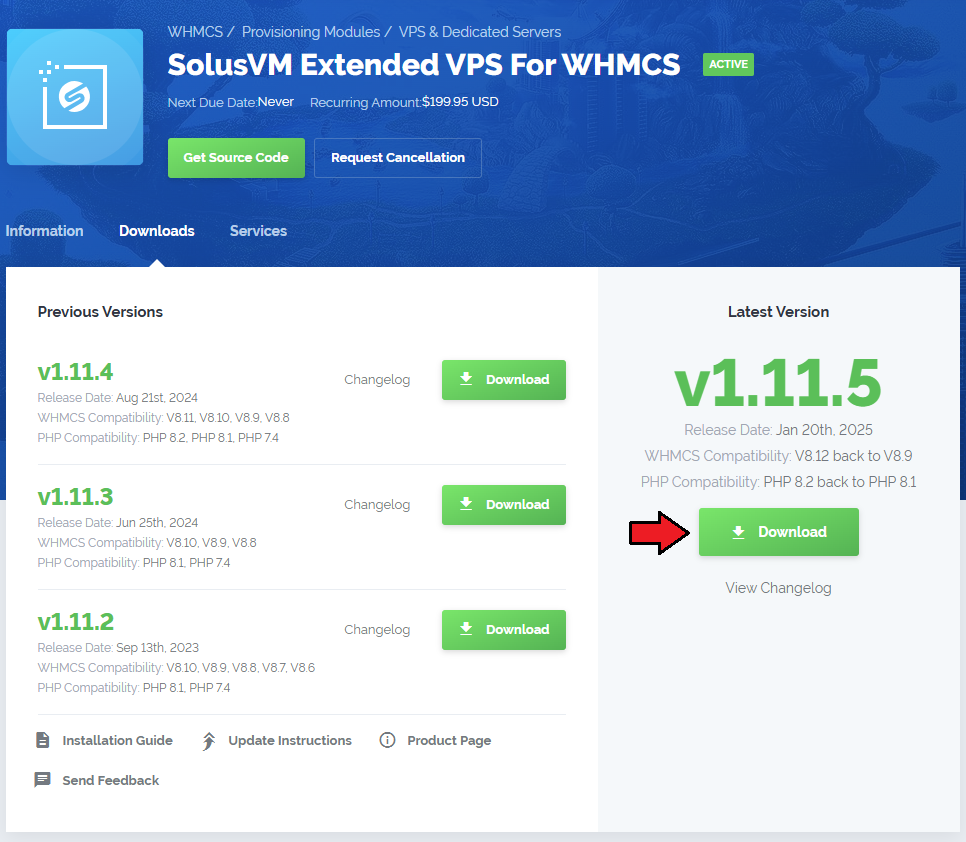
|
| 2. In the downloaded file you might find one or two packages that support different PHP versions. In the most recent versions of the module, you will find only one package that supports PHP 7.2 and later. |
| Previous updates of the module may contain two packages dedicated to various PHP versions. The first one that supports PHP 5.6 up to PHP 7.1, and the second one addressed to PHP 7.2 up to PHP 7.4. |

|
| Note: You can check the current PHP version in your WHMCS. To do so, proceed to 'Utilities' → 'System' → 'PHP Info'. |
| 3. Extract the package and upload its content into the main WHMCS directory. The content of the package to upload should look like this. |

|
| 4. When you install SolusVM Extended VPS For WHMCS for the first time you have to rename 'license_RENAME.php' file. File is located in 'modules/servers/solusvmExtendedVPS/license_RENAME.php'. Rename it from 'license_RENAME.php' to 'license.php'. |
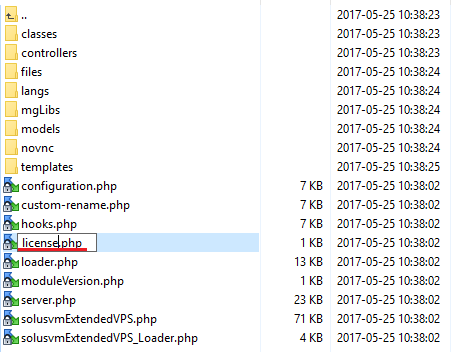
|
| 5. In order to configure your license key, you have to edit a previously renamed 'license.php' file. Enter your license key between quotation marks as presented on the following screen. You can find your license key in our client area → 'My Products'. |

|
[edit] Configuration of API Access
| 6. Now, we will show you how to configure a new product. Firstly, log in to your SolusVM admin area, go to 'Configuration' → 'API Access' and press 'Add API User'. |

|
| 7. Fill in your IP address and once again click on 'Add API User' button. |

|
[edit] Configuration of Server
| 8. Now, log in to your WHMCS admin area and proceed to 'System Settings' → 'Servers'. Afterwards, press 'Add New Server'. |
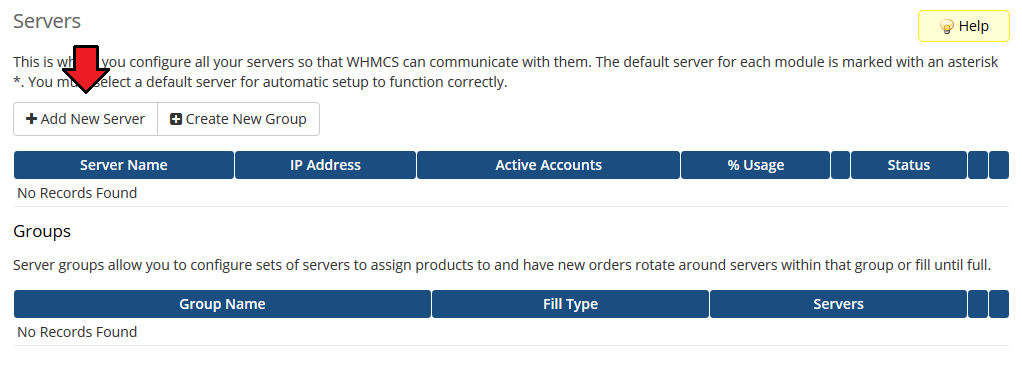
|
| 9. Enter your server name and IP address. Choose 'SolusvmExtendedVPS' from a dropdown menu and provide:
Check if your server use SSL connection and optionally provide a custom port (by defualt the '5656' is used). |
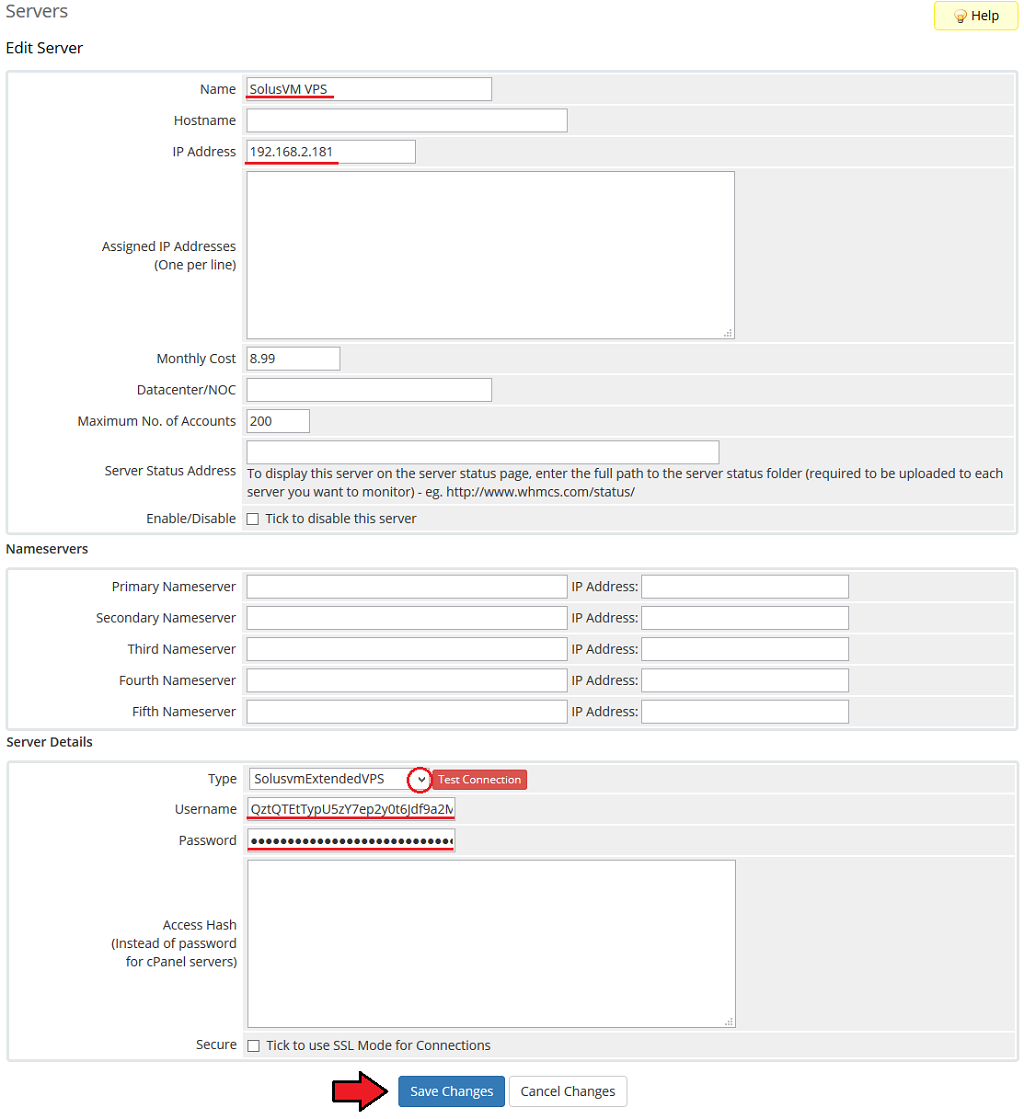
|
| 10. After configuring your server correctly, you are going to see the following screen. Test your connection and API key through pressing 'Test Connection'. |
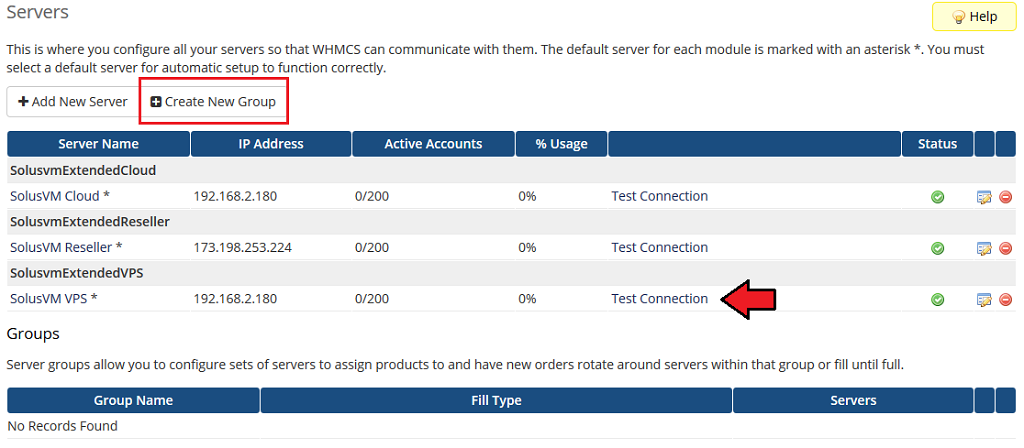
|
| 11. Fill in name, choose a previously created server and press 'Add'. Confirm by clicking on 'Save Changes'. |
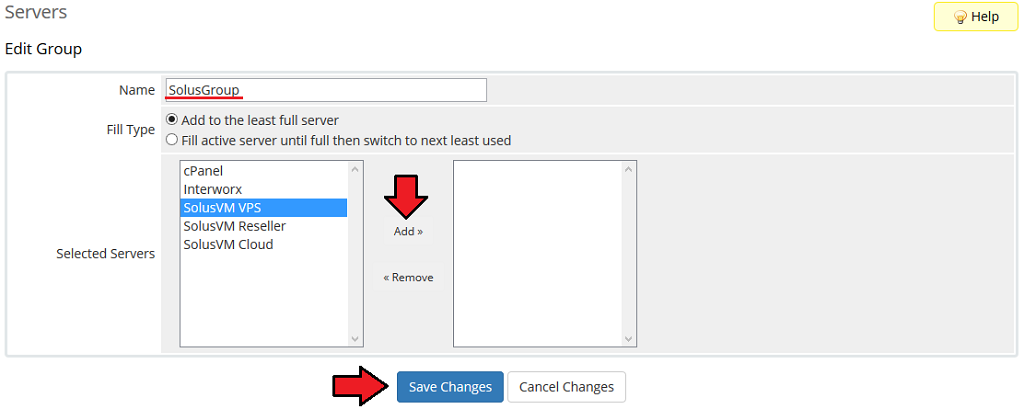
|
[edit] Configuration of Product
| 12. In order to create and configure product, go to 'System Settings' → 'Products/Services'. Afterwards, click on 'Create a New Group'. |

|
| 13. Fill in a product group name and press 'Save Changes'. |
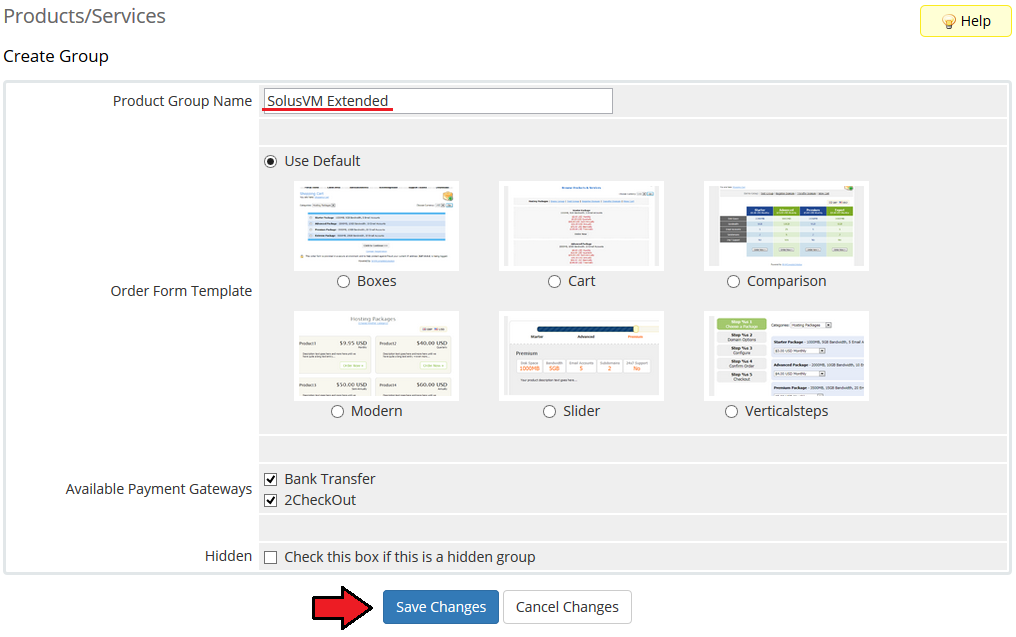
|
| 14. When you have a product group, you can create your product and assign it to SolusVM Extended VPS. To create a product click on 'Create a New Product'. |

|
| 15. Afterwards, choose your product type and product group from dropdown menus, fill in your product name and press 'Continue'. |

|
| 16. Now, go to 'Module Settings' section, choose both 'SolusvmExtendedVPS' and a previously created server group from dropdown menus. Afterwards, press 'Save Changes'. |
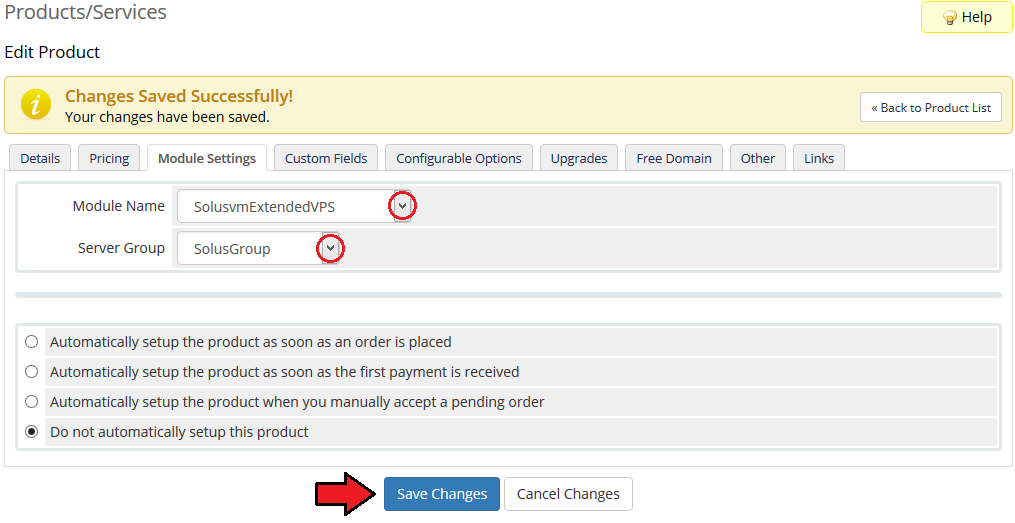
|
| 17. Start configuration of a product with 'Product Configuration' section. Select desired 'Virtualization Type' and press 'Save Changes' in order to load the virtualization. |
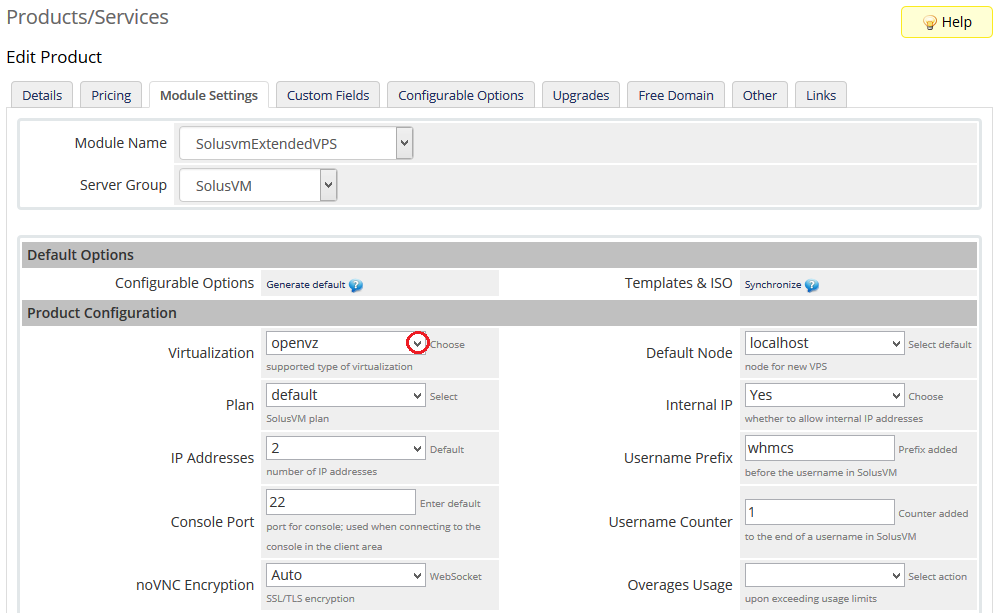
|
| 18. Now, choose 'Default Node', 'Plan', 'Default Operating System', 'Number of IPs' and 'Default Node Group'. Note: default data will be used if no configurable options are generated! |
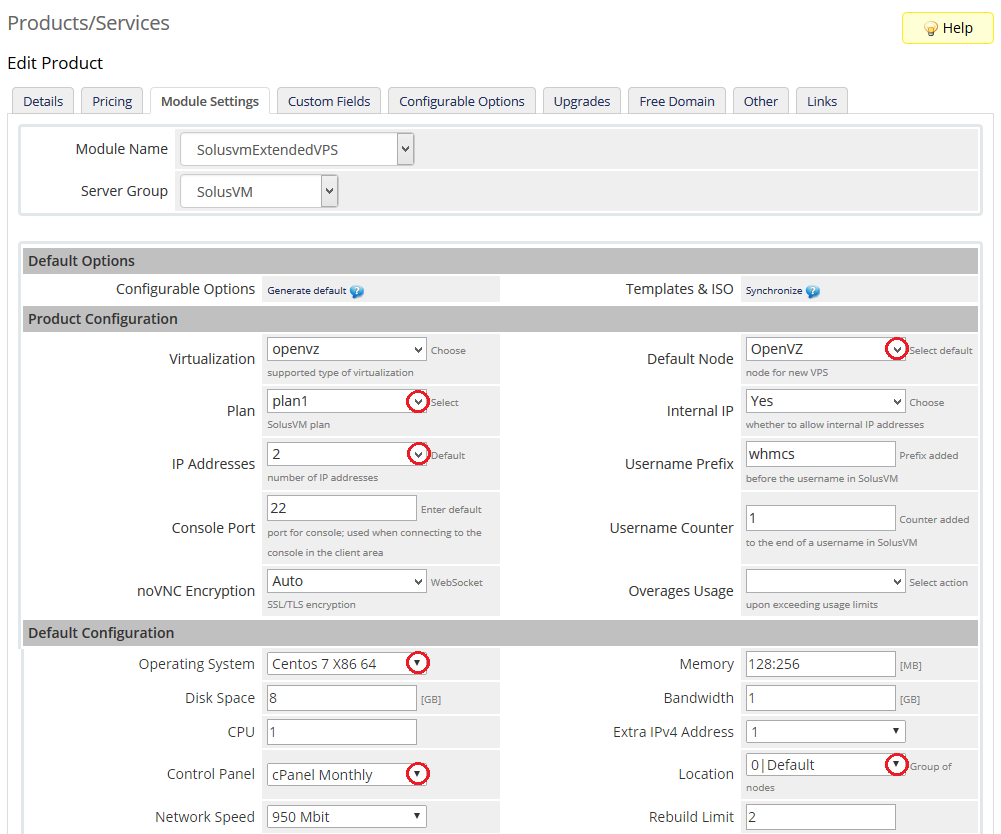
|
| 19. Define features available in the client area through marking/unmarking them under 'Client Area Features' section. Important: Keep in mind that the root password is generated automatically for KVM virtualization upon its creation and reset. |
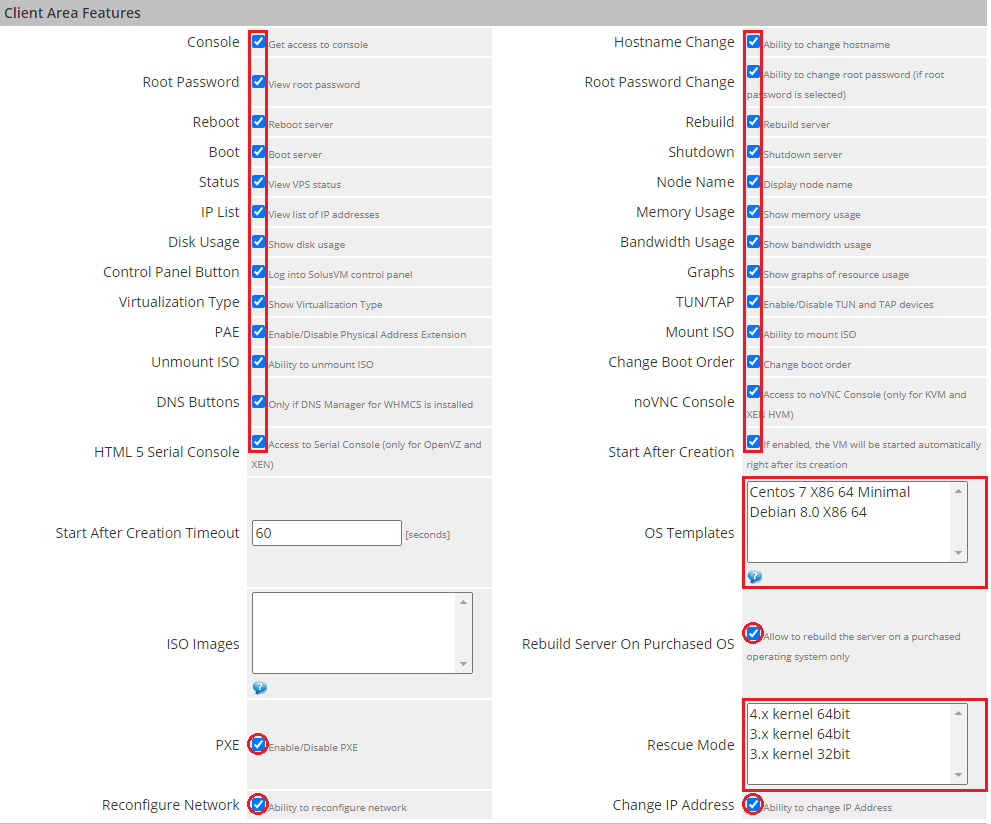
|
| 20. At the very bottom you may change available nodes names to any friendly name. |
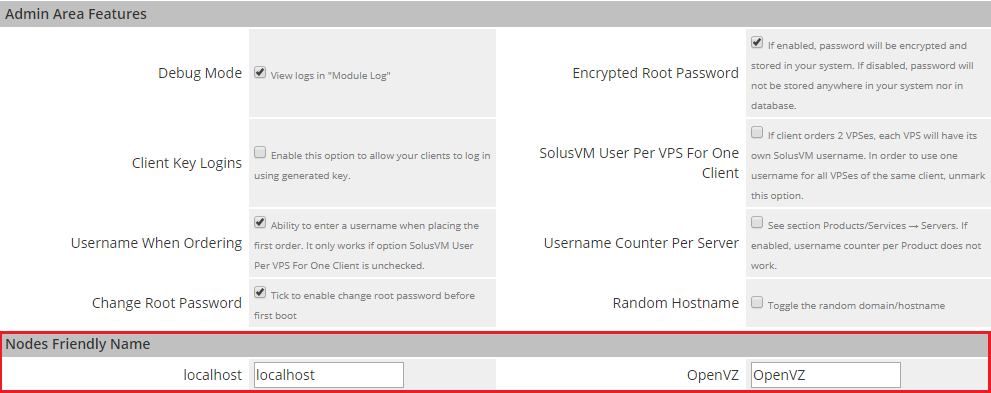
|
| 21. The final step is generating default configurable options. To do so, press 'Generate Default' near 'Configurable Options' as shown on the screen below. |
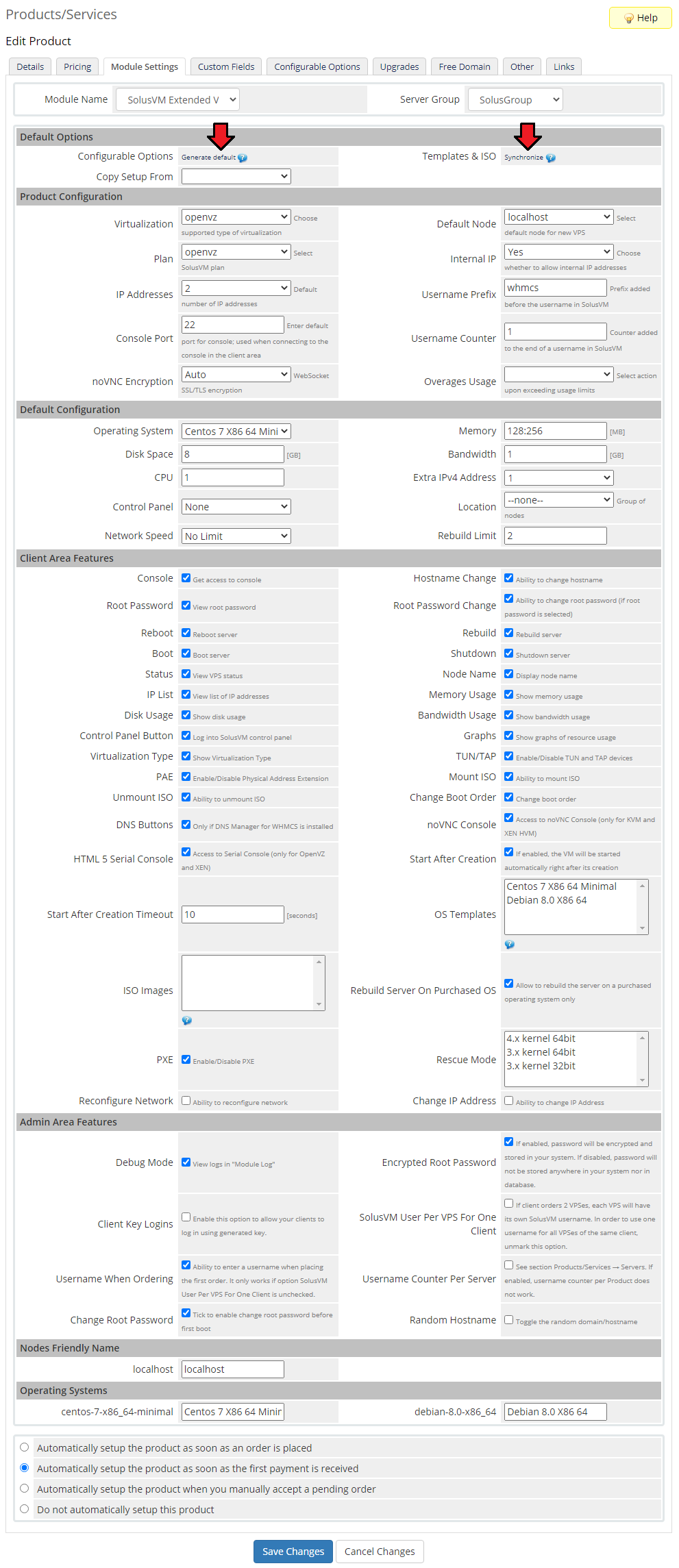
|
| You have just finished the installation and configuration of the module! |
[edit] Management
| SolusVM Extended VPS For WHMCS offers very intuitive management of virtual servers both for your admins and clients. In addition, it provides you with the ability to offer your clients VPS tailored to their needs. |
[edit] Interface
| Now let's check the interface of the module in your WHMCS client area. As you can see, everything your customers need is in one place. Note: List of available features depends on the selected virtualization. |
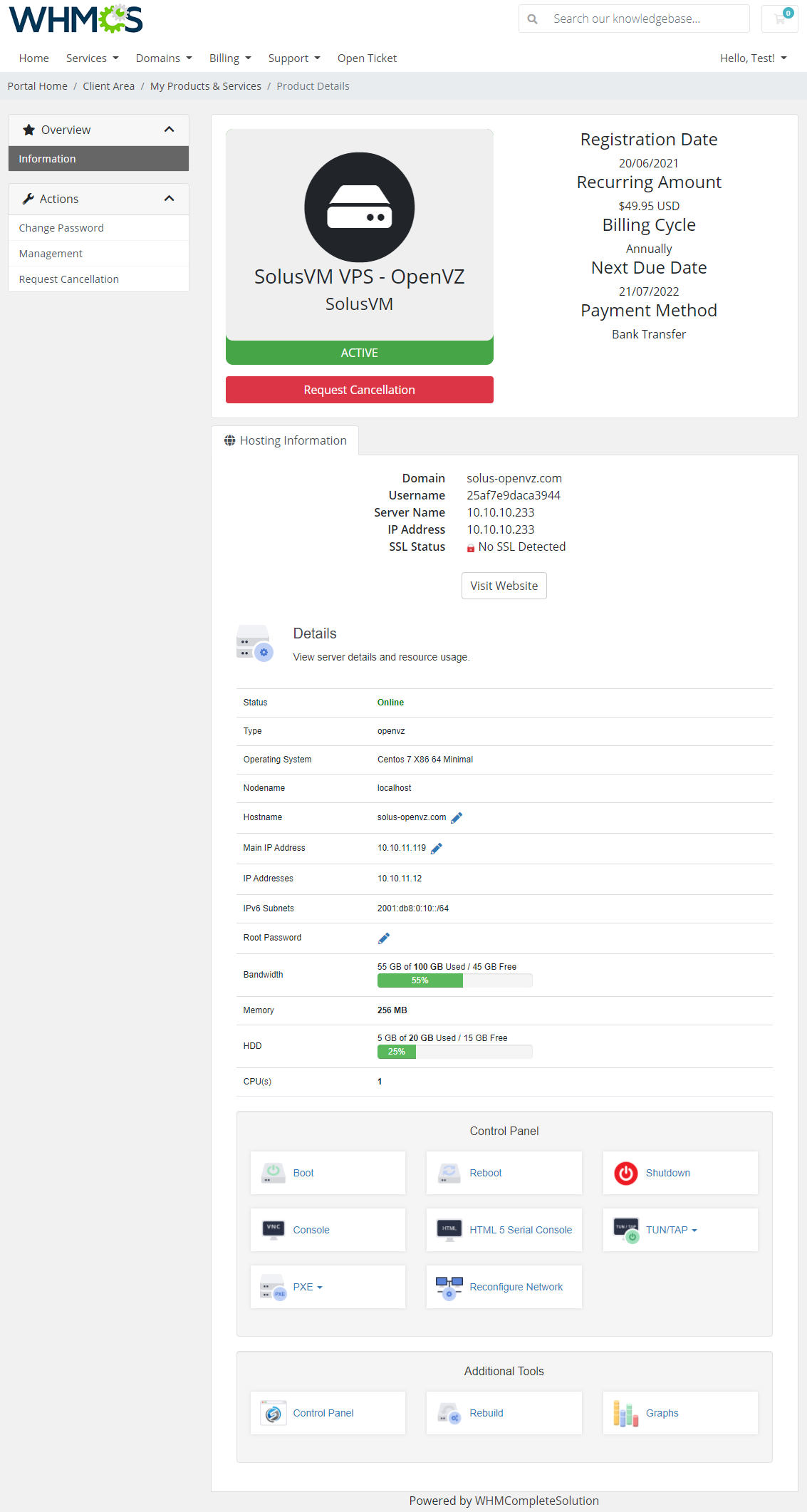
|
| You can monitor and manage each product from your WHMCS admin area. |
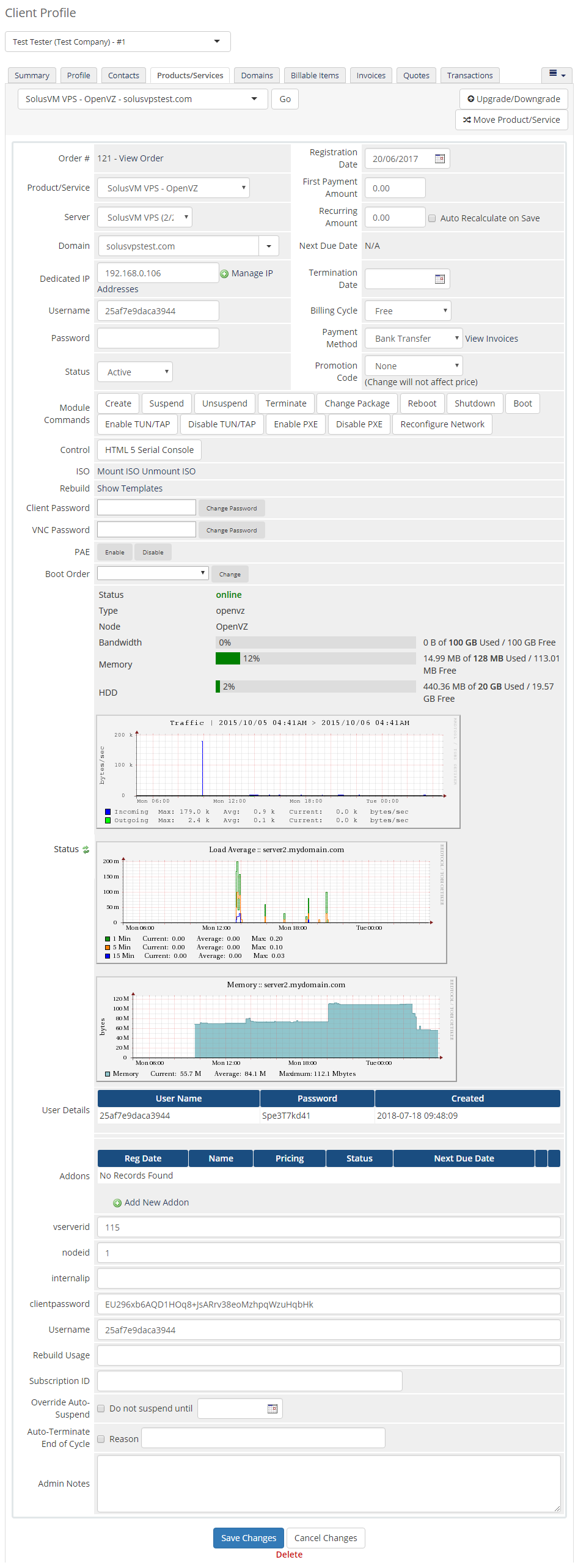
|
[edit] Management of Server
| Module allows your customers to easily manage your server: boot, reboot, shutdown, access SSH/VNC/HTML5 console, enable/disable PAE and PXE or reconfigure network. Additionally, you can log into control panel, rebuild servers and view usage graphs. In addition to that, your clients can change hostname and root password. |
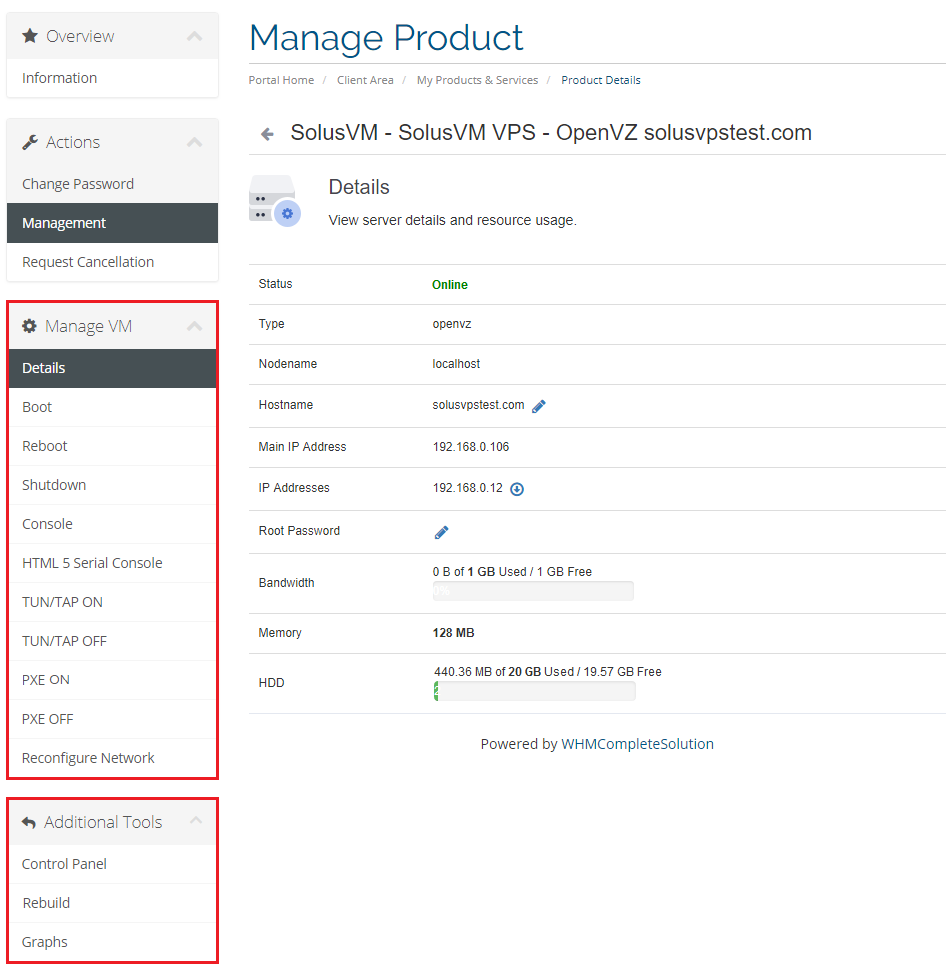
|
| As you can see on the following screen, a VPS of KVM type is different than OpenVZ type. The most noticeable difference is noVNC Console near Console button. |
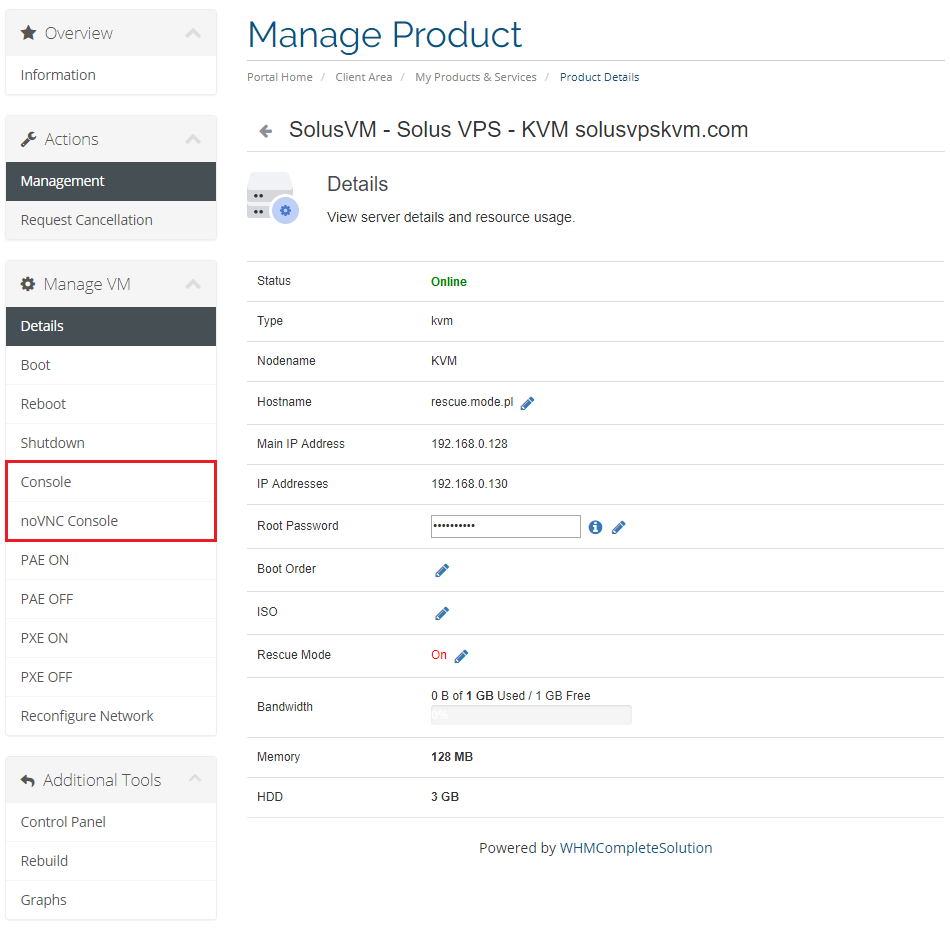
|
[edit] SSH Console
| It's one of the most interesting functionalities is SSH console, where your clients can remotely manage the server. To access it, simply press 'Console' button. Note: This type of console is available only for OpenVZ & Xen virtualization. |
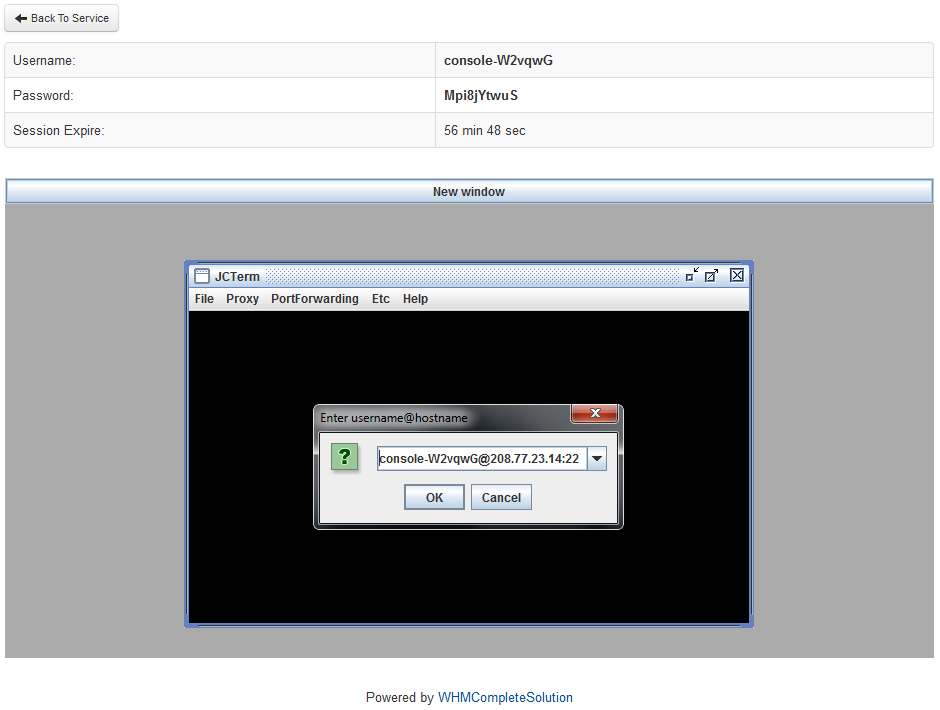
|
[edit] VNC Console
| The module also enables remote access to VNC console. Note: VNC console is used by KVM and Xen HVM virtualization. |
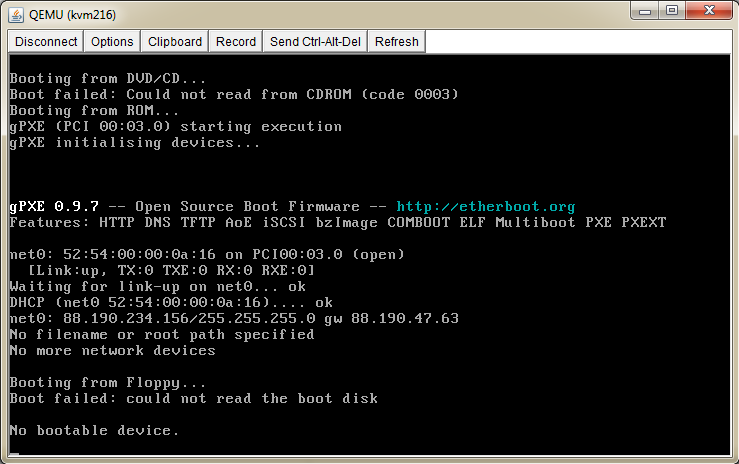
|
[edit] HTML5 noVNC Console
| The module also enables usage of HTML5 noVNC console. Note: noVNC console is used by KVM and Xen HVM virtualization. |
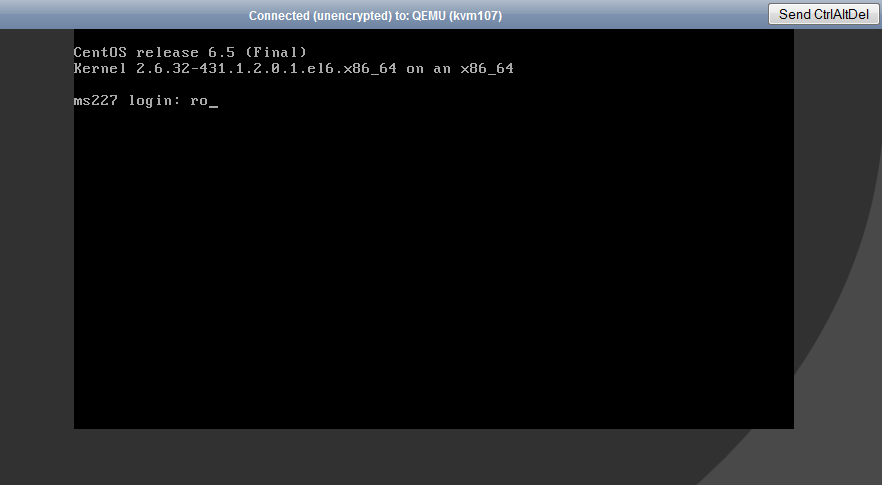
|
[edit] HTML 5 Serial Console
| And the last supported console is HTML 5 serial console. Please be informed that the installation of some dependencies is mandatory within your SoulsVM instance, in order to use the console. Note: HTML 5 Serial Console is used by OpenVZ and Xen virtualization. |
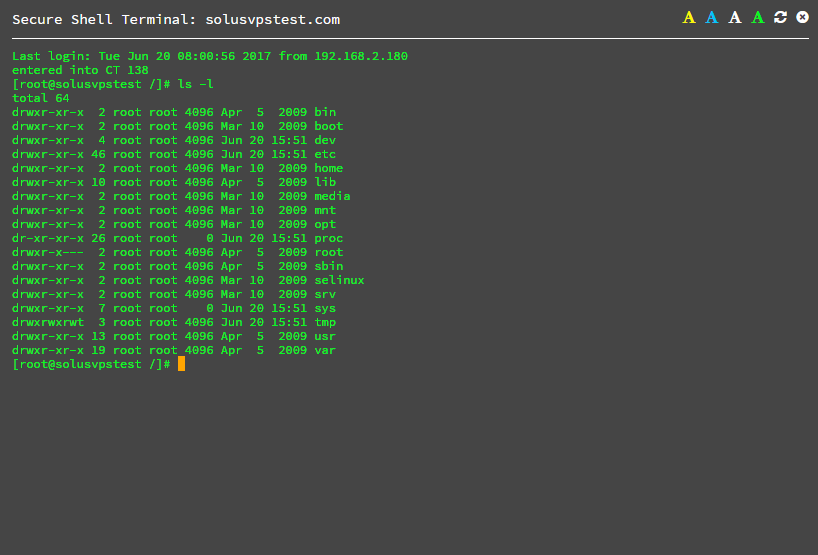
|
[edit] Rebuild
| Rebuild feature allows you to change OS template from available OS templates list. To rebuild your server click on 'Rebuild' button, choose template and confirm by pressing 'Rebuild' button. |
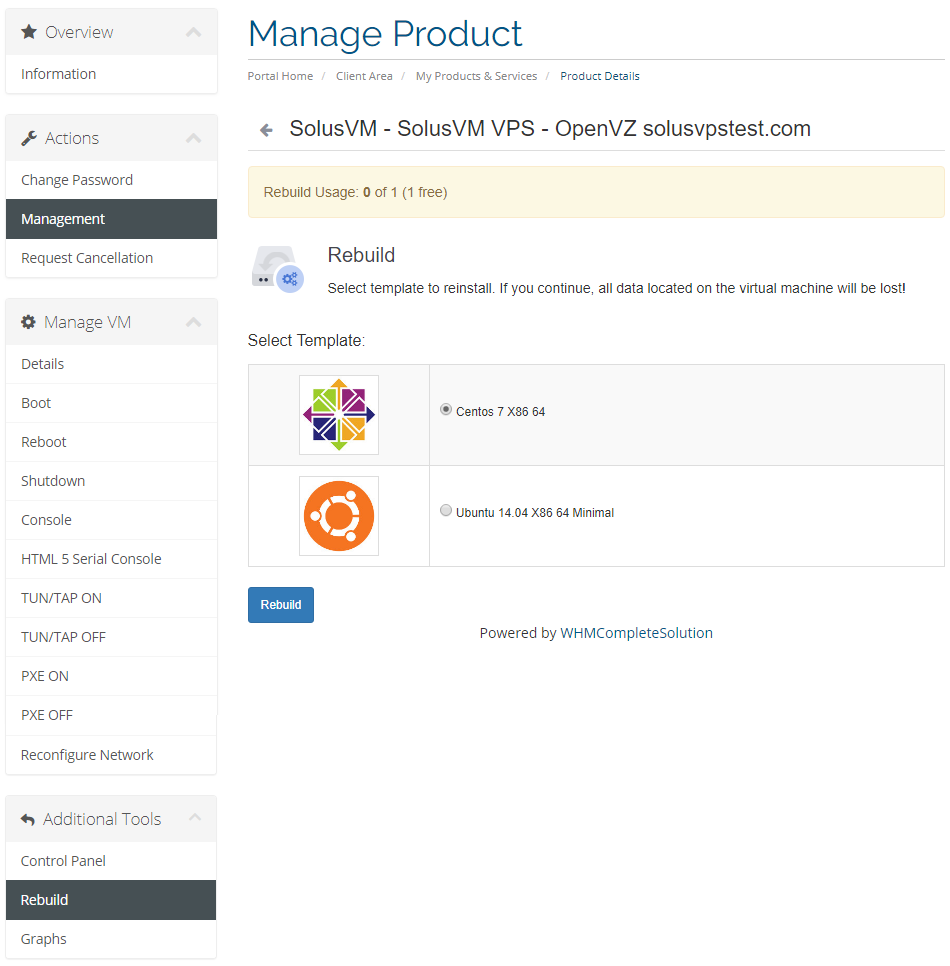
|
[edit] Graphs
| Move to 'Graphs' section. You will find there visualizations of your current 'Network Traffic', 'Load Average' and 'Memory Usage'. Tracking your VPS usage you avoid sudden and unexpected overload. |
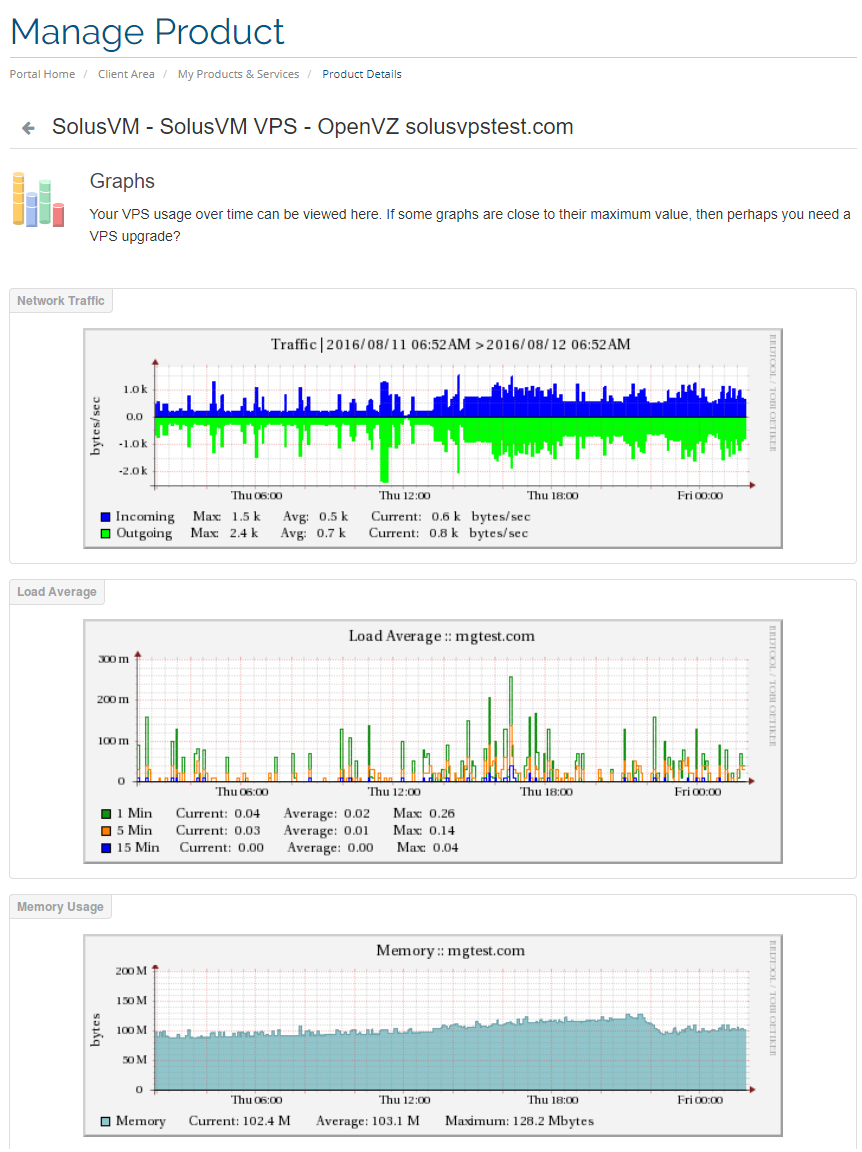
|
[edit] Rescue Mode (KVM Only)
| One of the options available is Rescue Mode that may be turned on/off by the client. It allows to boot the server directly into the rescue mode. Press to enable this functionality. |
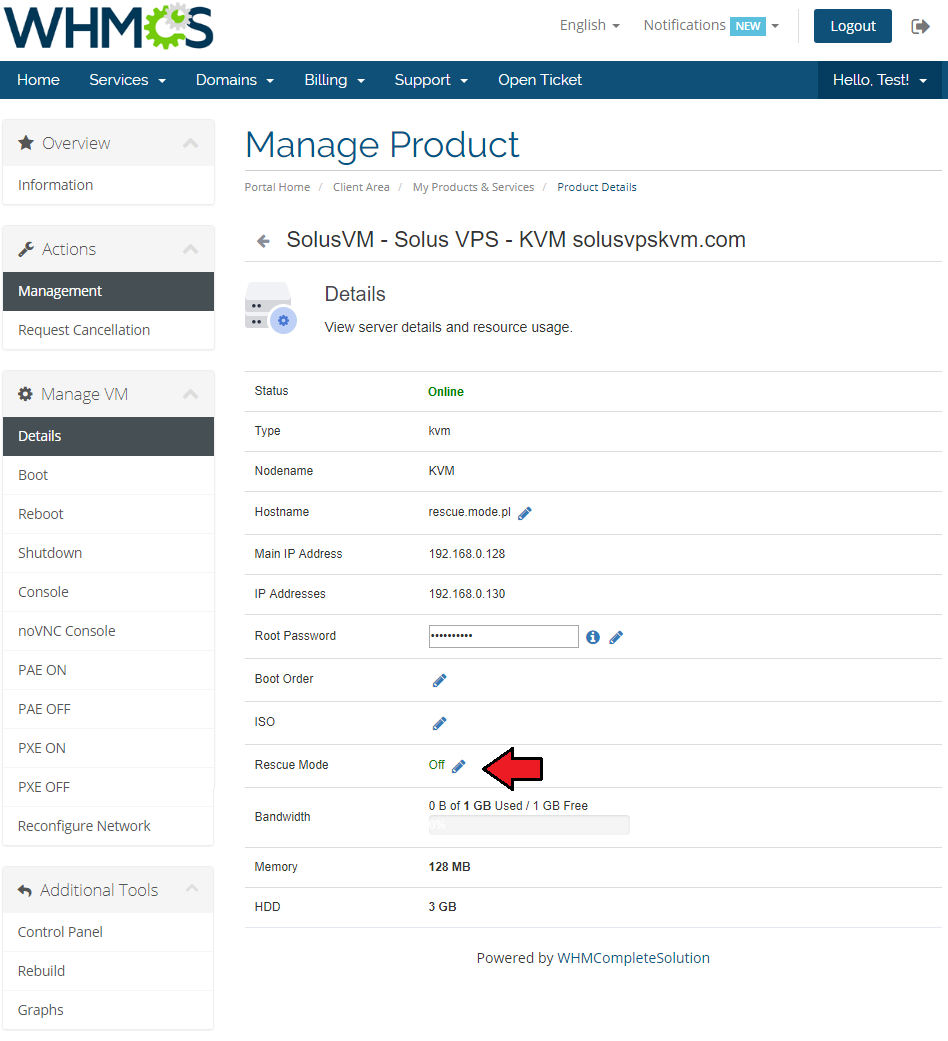
|
| A pop up window appears, select a kernel from the list of available and enable it. SSH details will be viewed immediately. |
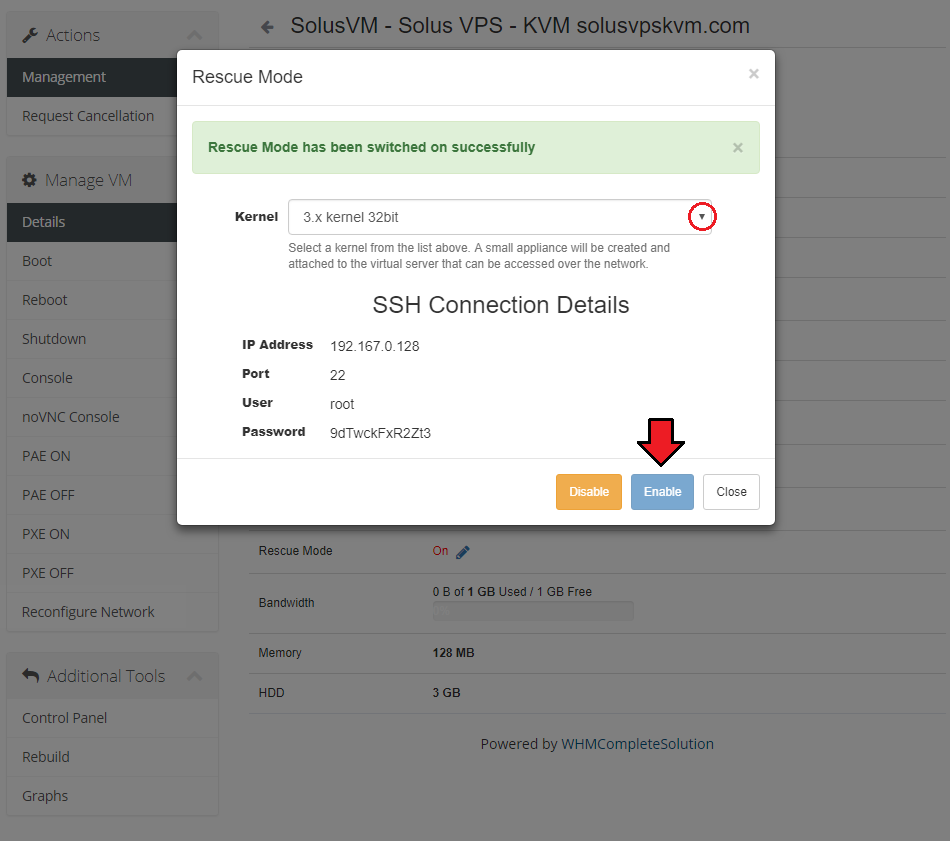
|
[edit] Management of Email Templates
| You can automatically send your customers emails with details of newly created virtual servers. To do so, create a new email template with 'Product' type and 'Unique Name' specified in SolusVM Documentation, in our case it is 'KVM Virtual Server'. |

|
You can paste the email content from SolusVM Documentation or create your own. Owing to our module, you can also use variables:
|
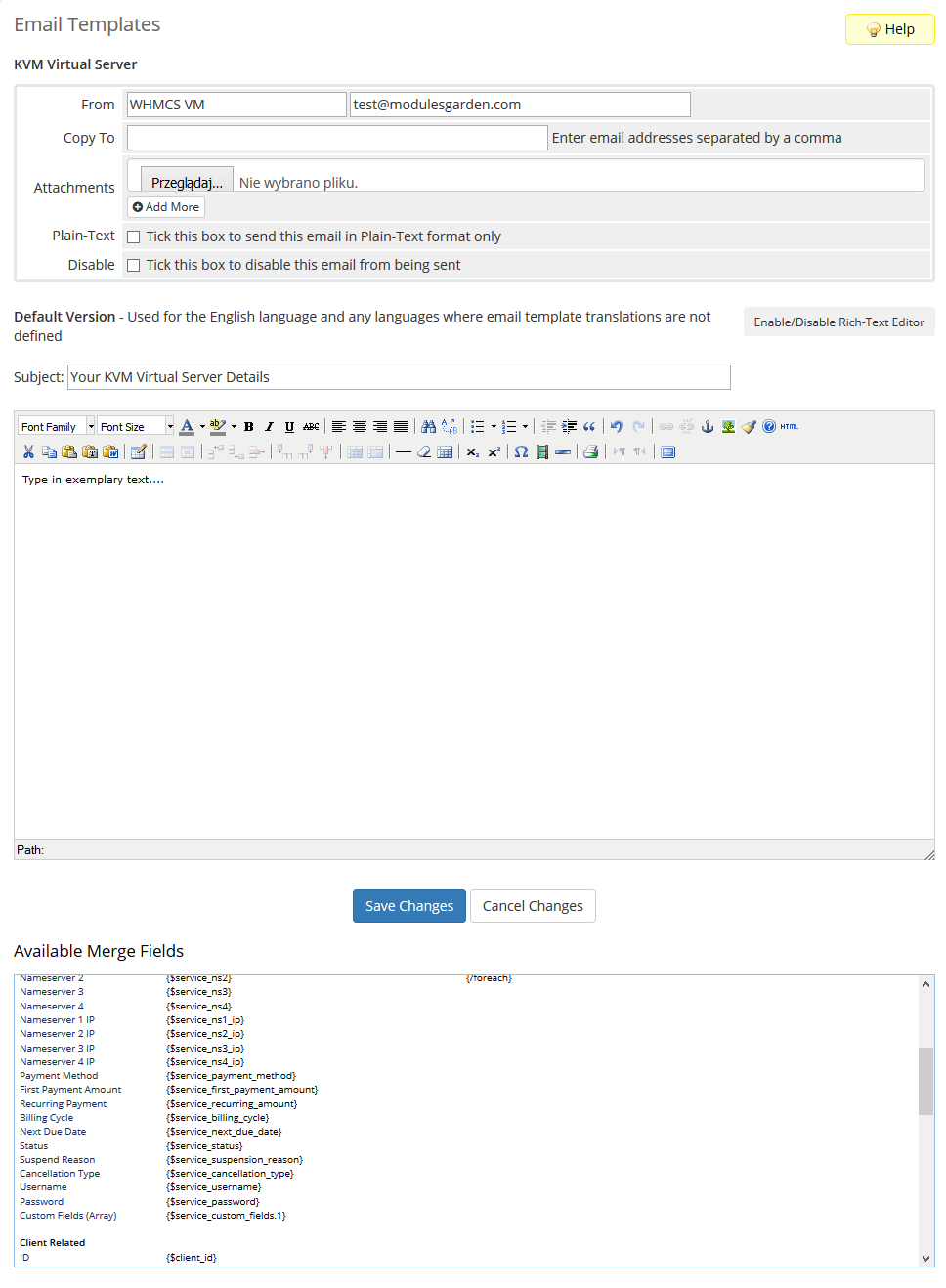
|
[edit] Management of Custom Hooks
| Our module allows you to use custom hooks. All you need is knowledge of PHP programming language. Possible hooks are:
To enable these hooks, you have to rename file 'custom-rename.php' to 'custom.php'. |

|
| Now your hooks are active, but since they are empty they do nothing. To find hooks' details, read a previously edited file. In the mentioned file you are going to find the hook, information about its time of run, returned values and parameters. |

|
[edit] Dynamic Server Resources Setup With Configurable Options
| If you wish to allow your clients to order servers with resources they choose, use configurable option group. To generate a configurable option group for a product, head to the 19th step of 'Configuration of Product' instruction. |
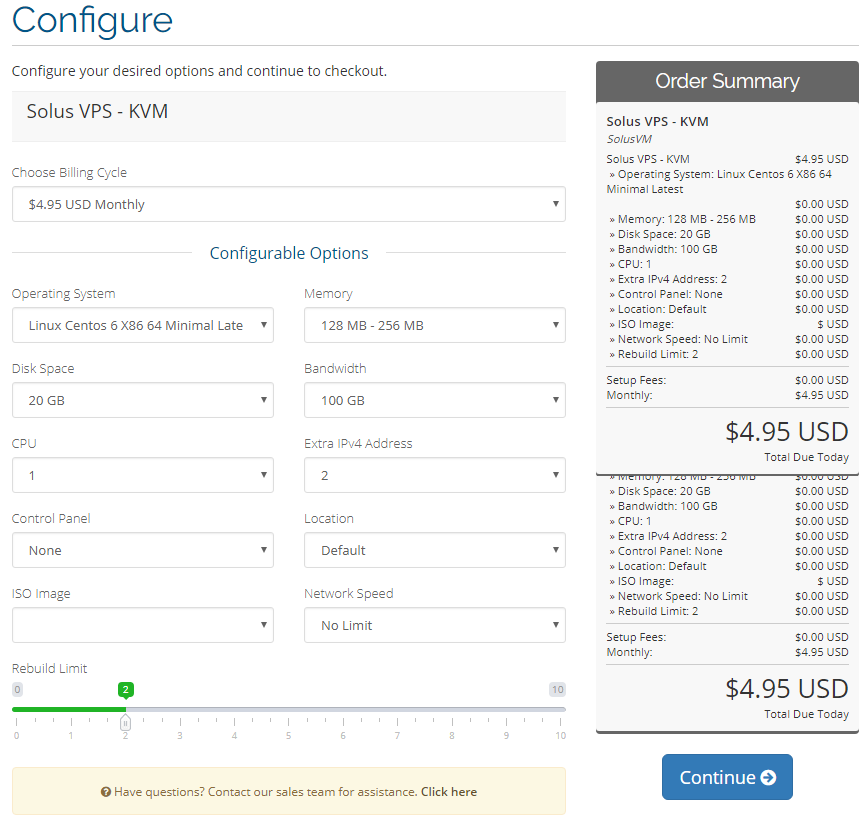
|
| If automatically generated configurable options do not fulfill your clients' needs, you can edit them using this guide. |
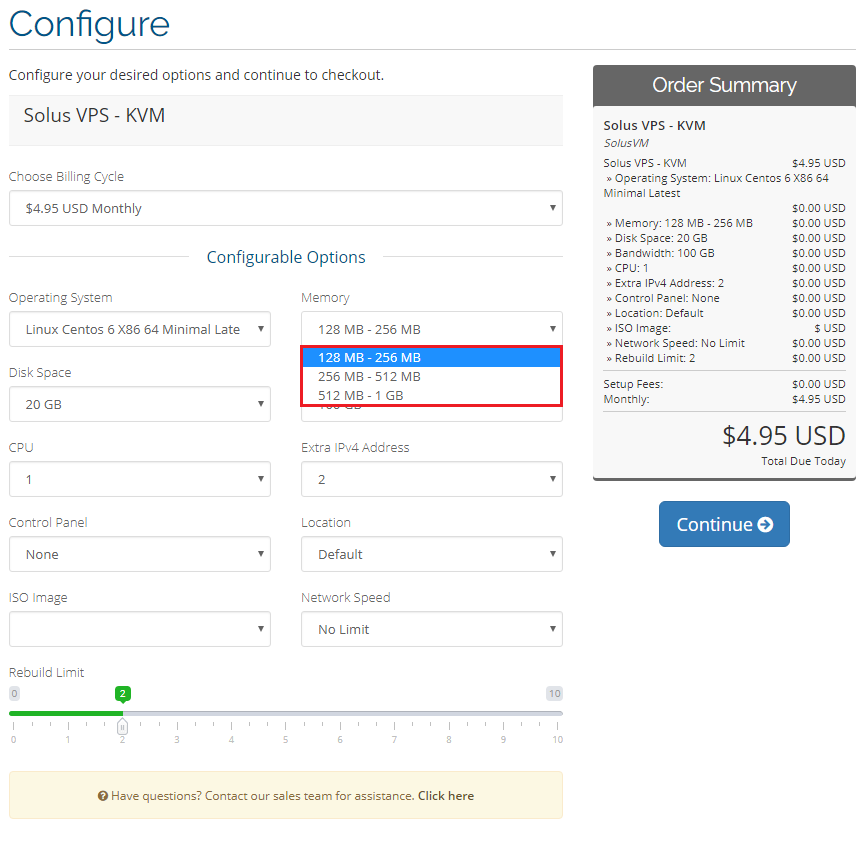
|
| If you decide to set up pricing depending on the ordered resource, you can find instruction on how to proceed here. |
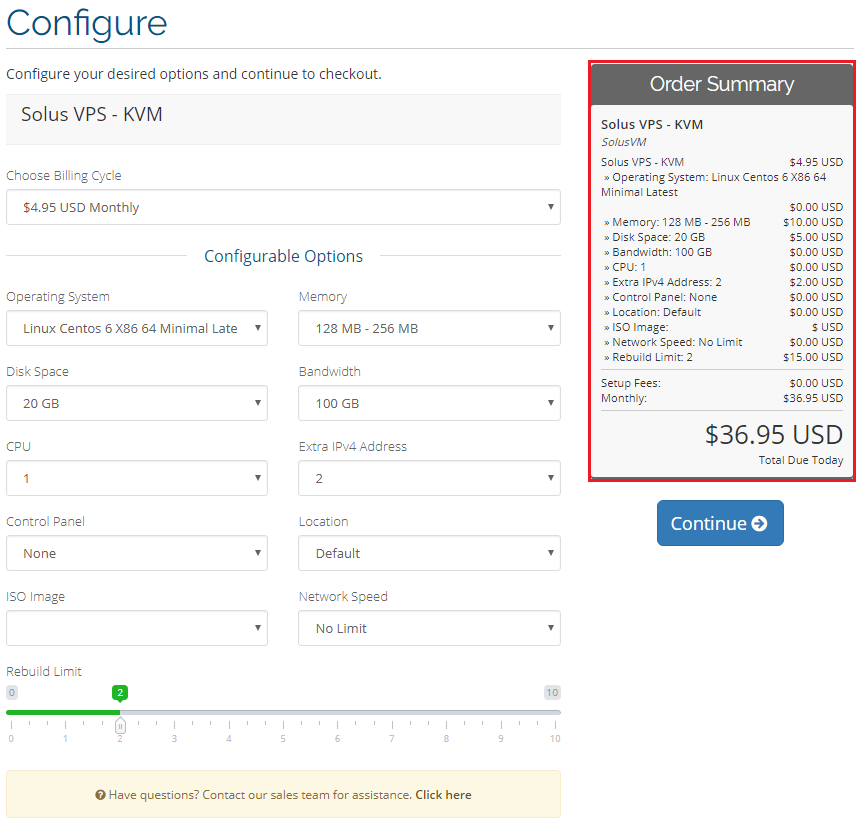
|
| If you prefer to charge your clients for server resources they actually use, you can use our Advanced Billing For WHMCS module. |
[edit] Management of DNS
| When you combine SolusVM Extended VPS For WHMCS with DNS Manager For WHMCS, your clients will be able to manage PowerDNS zones and records from the client area. DNS Manager For WHMCS will allow your customers to manage DNS zones, records and ReverseDNS. |
| To connect both modules, go to 'Settings' → 'Packages' section of DNS Manager and add a new package. |
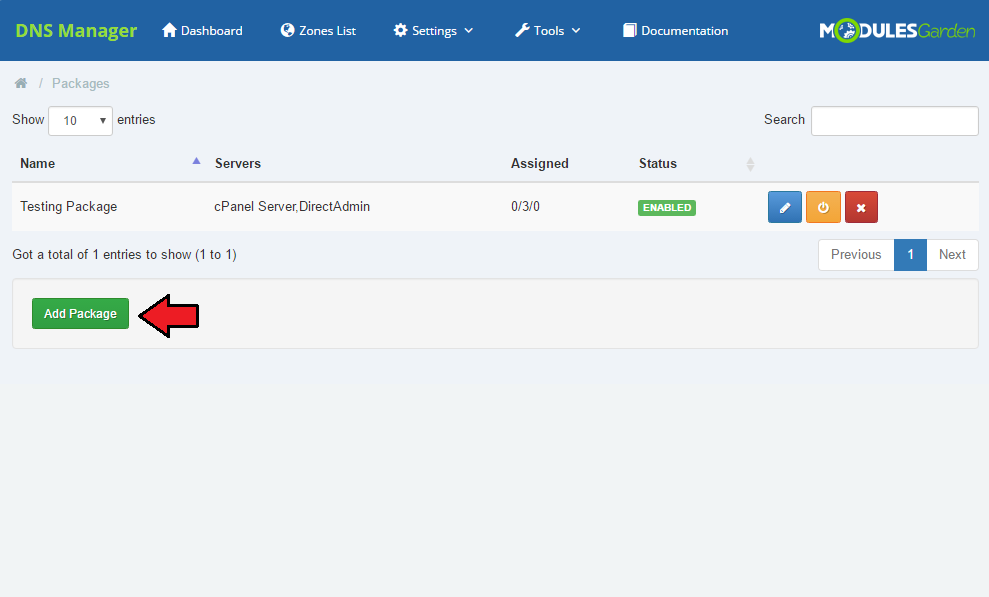
|
| Name the package and provide any details you find useful. Then proceed to 'Item' section. |
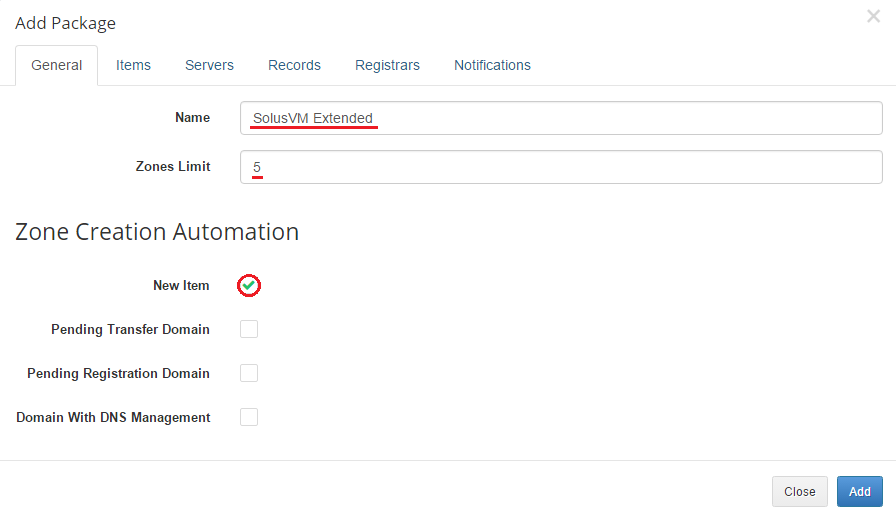
|
| Select SolusVM Extended VPS from the list of products and click on 'Add' . |
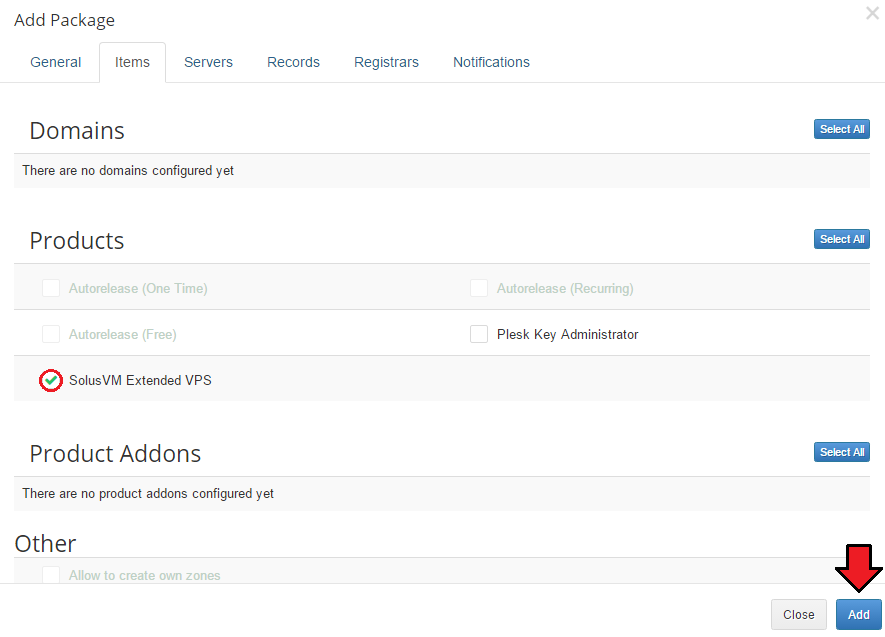
|
| Your package should now appear on the list. To change its status click on the button as shown below. |
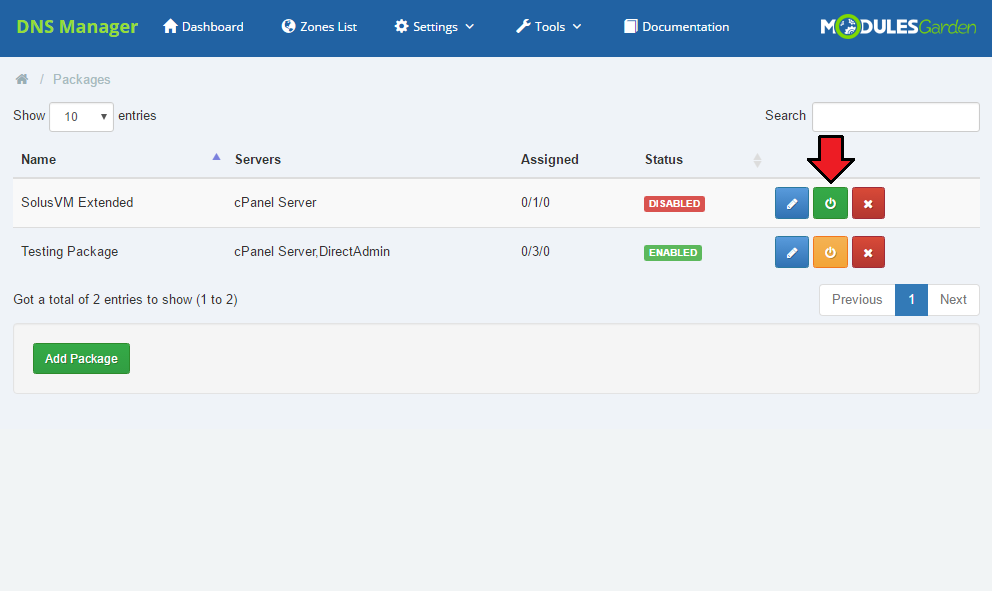
|
| Once done, you will see a proper note. |
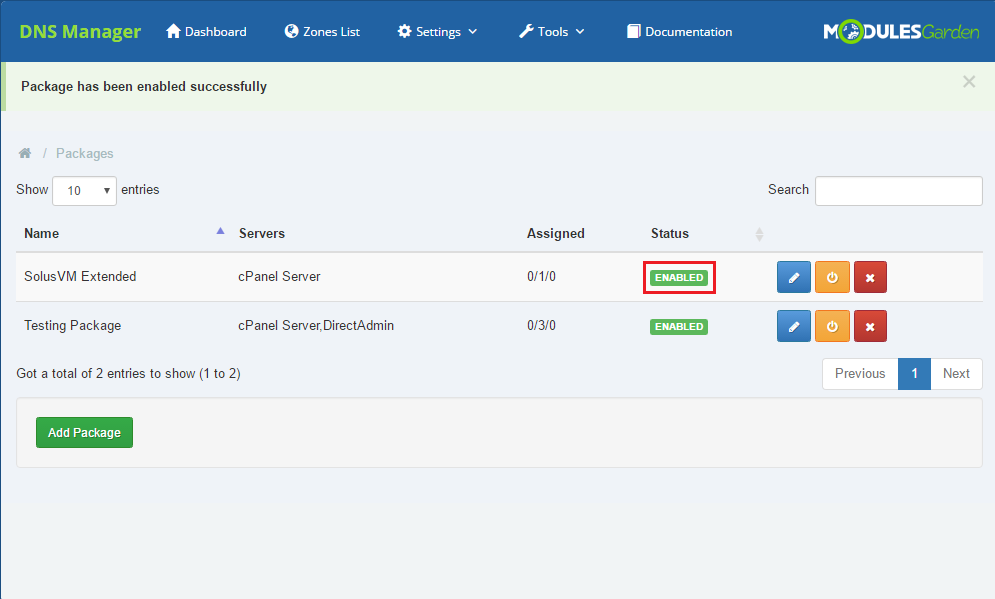
|
| Afterwards, buttons 'Manage DNS' and 'Manage Reverse DNS' will appear in the client area as shown on the screen below. |
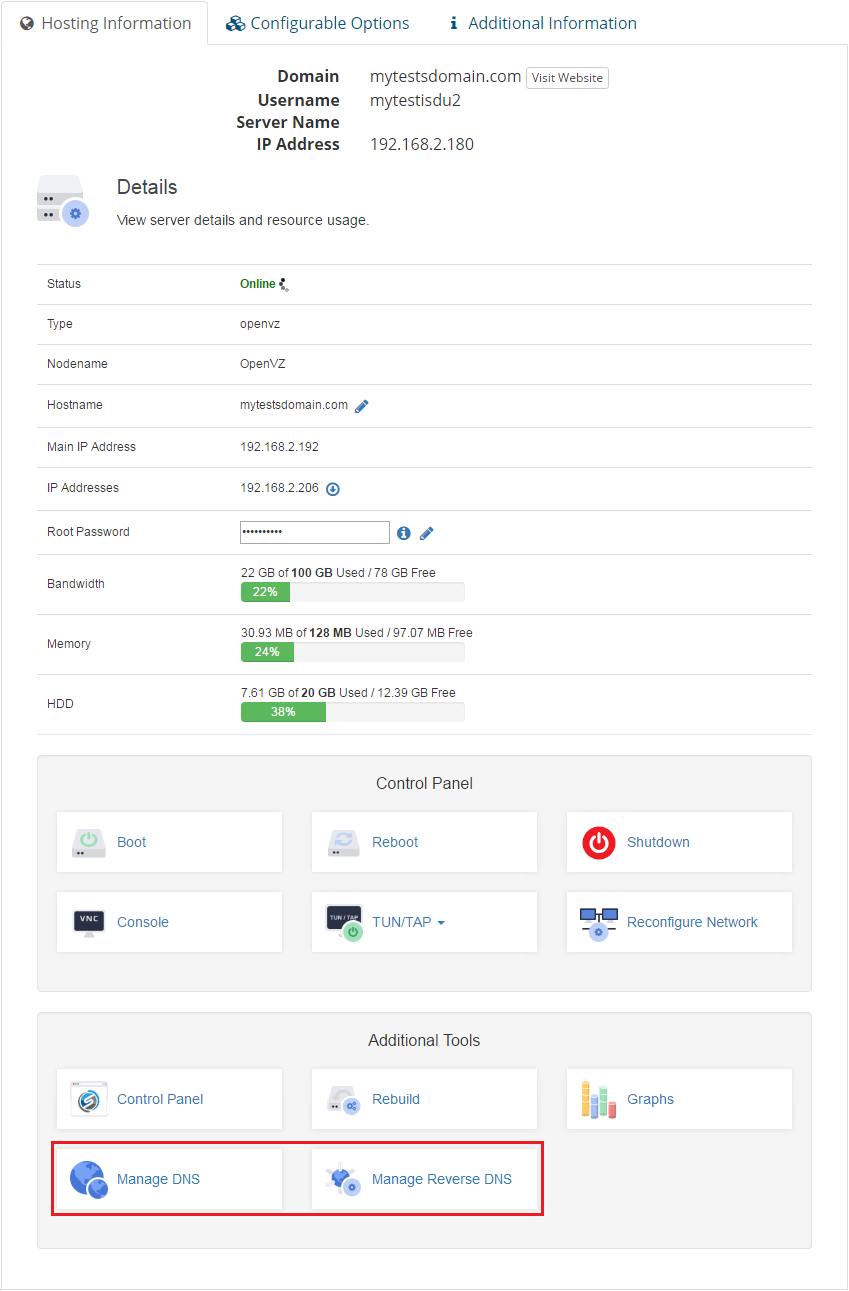
|
| You can find 'Manage DNS' option also in the left menu. |
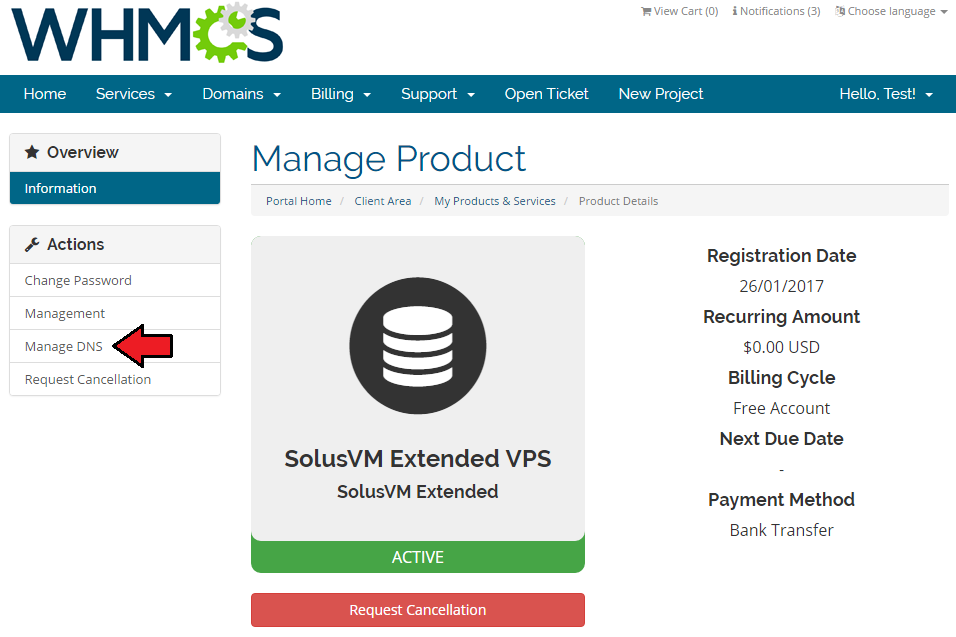
|
| Depending on previously chosen settings, your customers will be able to add and remove DNS zones. |
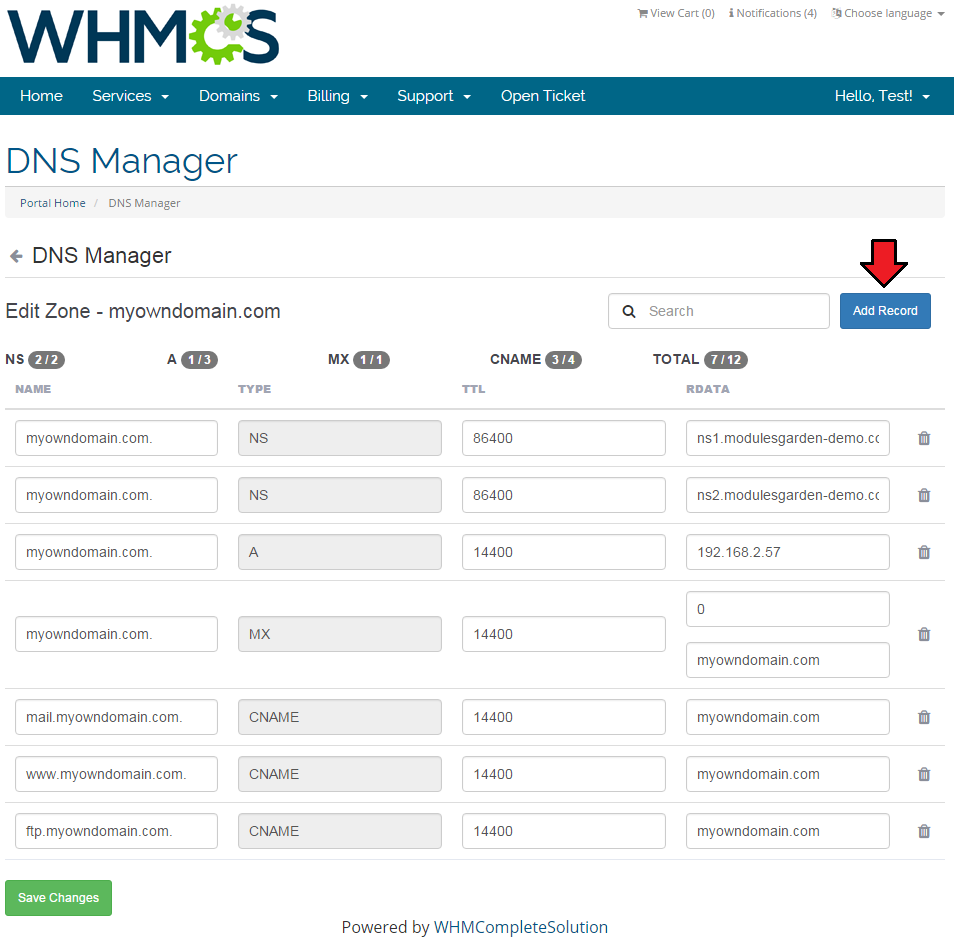
|
[edit] Management of Billing
| When you combine SolusVM Extended VPS For WHMCS with Advanced Billing For WHMCS, you will be able to set up additional billing options. |
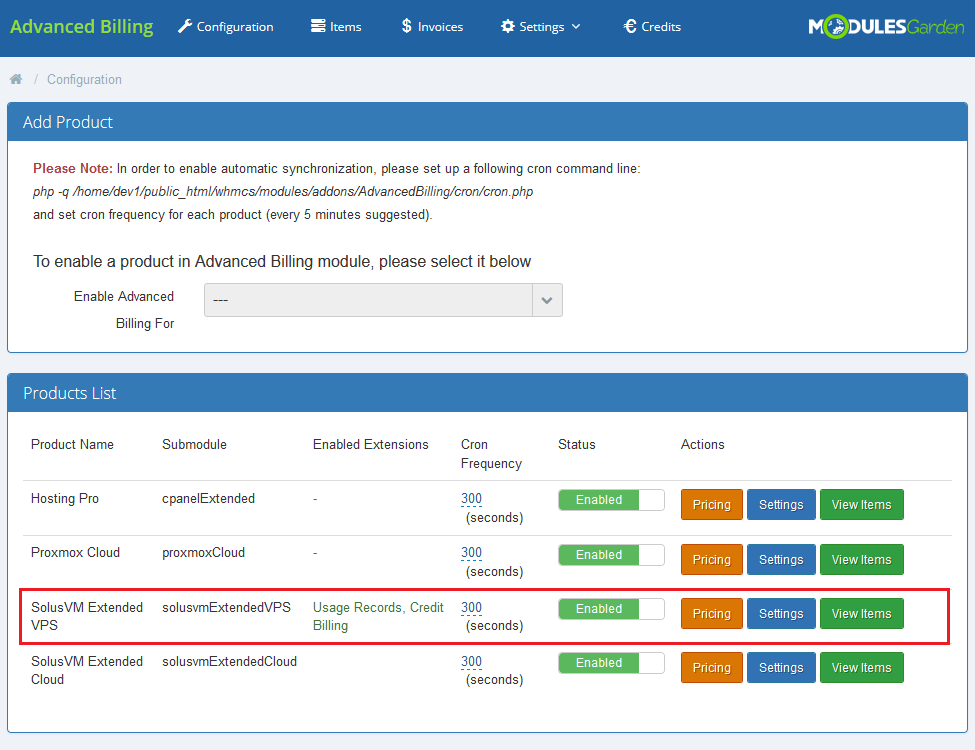
|
| The module allows you to charge your customers basing on the server resources they use. |
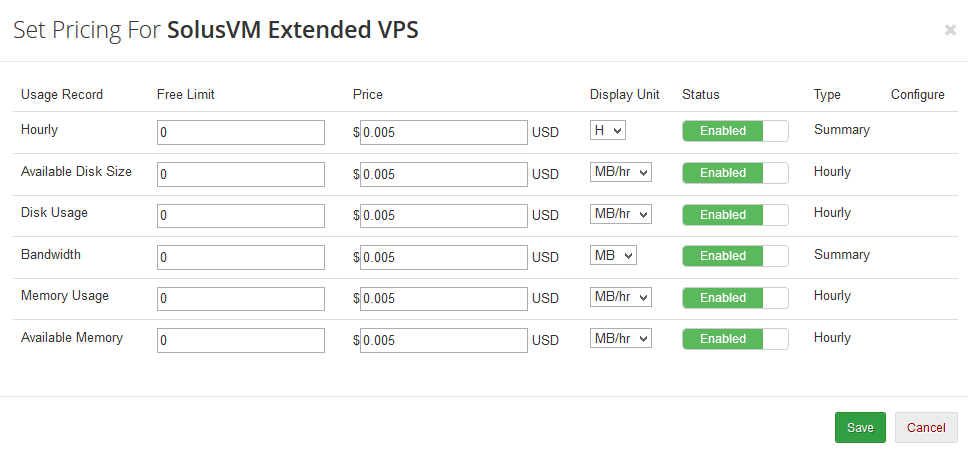
|
| With Advanced Billing module, you can also display the current server resource usage and their cost, as well as other allowed in Advanced Billing options that are on offer. |
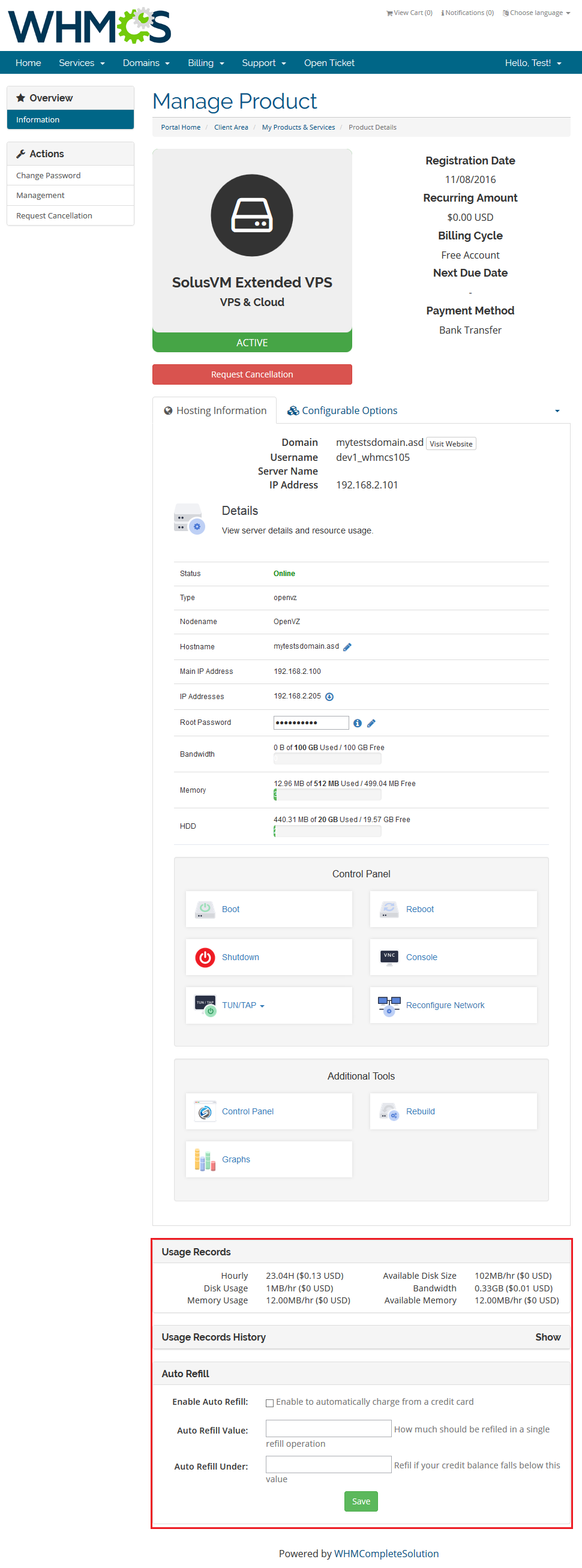
|
[edit] Debug Mode
| SolusVM Extended VPS is a very complex module. Therefore many things might go wrong. To help you quickly solve various problems usually connected with WHMCS product/server configuration and SolusVM server configuration, we created 'Debug Mode'. |
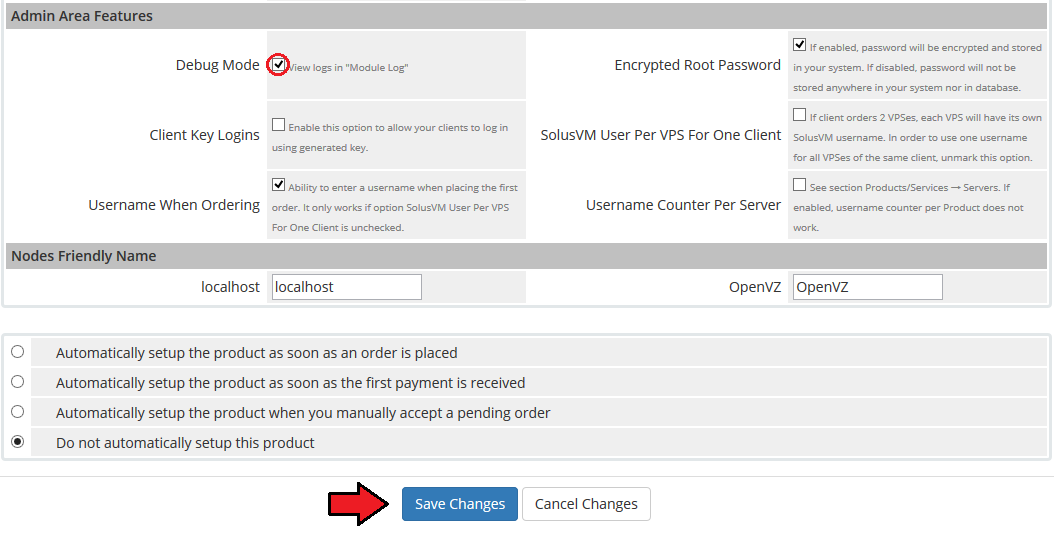
|
| Afterwards, go to 'Utilities' → 'Logs' → 'Module Log' and click on 'Enable Debug Logging' in order to enable it. Now, each action performed by the module will be recorded in the module log. |
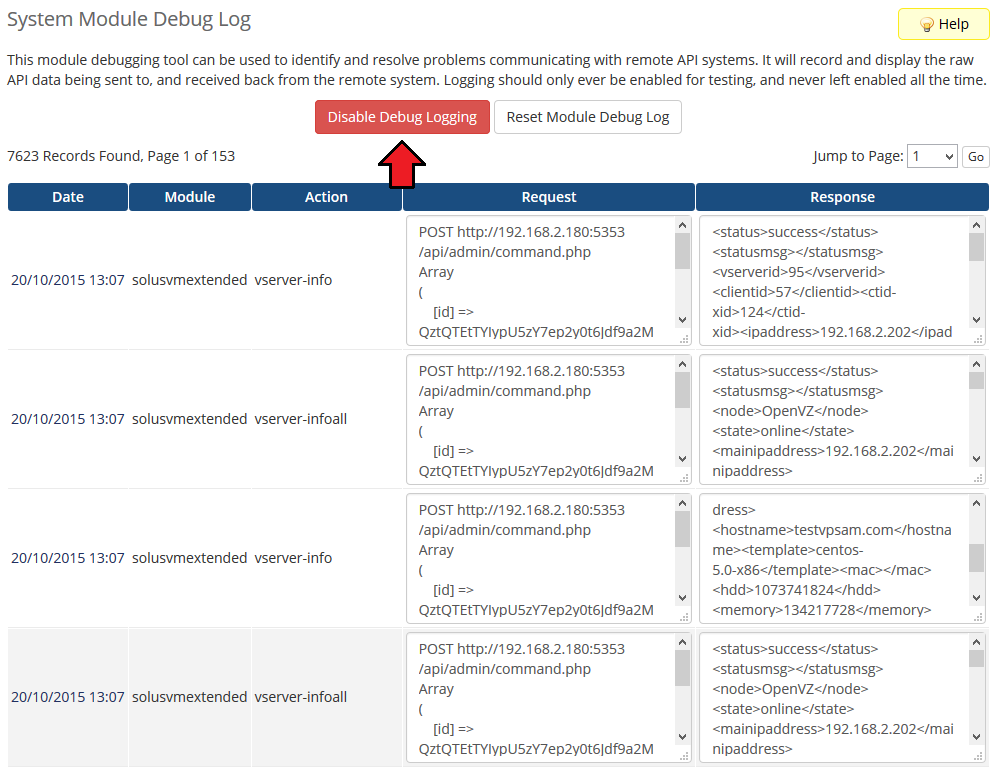
|
| Remember to turn off Debug Mode after you fix the problem. |
[edit] Importing Existing VPS
| In this section, you can find short instruction on how to connect one of your clients to your already existing VPS in Solus panel. Take the following steps to make sure that the process will be carried out properly. 1. Firstly, manually create an order for your customer in WHMCS. Choose a client and in the summary, view click on the ' Add New Order' button. Next, select a 'Product/Service' and press 'Submit Order' .
The above-mentioned information has to be consistent with the data from your Solus panel. Now, complete these fields as presented below. |

|
| 3. If the completed data is correct, after refreshing the page, you will see the attached VPS from Solus. Important! Remember to manually add other missing parameters of the VPS such as domains, credentials, IP Addresses, configurable options, SSH Key, billing cycle, etc. so they match the parameters of the attached VPS from Solus. |
[edit] Tips
| 1. We made every effort to make our module as easy to install, configure and use, as possible. Therefore, we paid special attention to displayed messages. Read each message carefully, follow the instructions and you shall have no problems using the module. |
| 2. Operations performed on the virtual servers are not executed immediately. Give your SolusVM server some time to process the request and execute the operation. |
| 3. In the current version of SolusVM API there is no possibility to automatically upgrade Virtual Machine, therefore you have to perform this action manually. Upgrading package in the SolusVM VPS Extended module means upgrading Solus Plan. |
| 4. As this module supports templates system, any changes made in the module's templates files will be saved after the upgrade process. |
| 5. If you want a random hostname to be generated, enable the 'Random Hostname' option in the 'Admin Area Features' of the module settings. |
[edit] Update Instructions
| An essential guidance through the process of updating the module is offered here. Ensure successful completion of the module update by carefully following each step, thereby preventing data loss or any unforeseen issues. |
[edit] Update of Products
| Our module is entirely compatible with SolusVM WHMCS Module (previously known as "SolusVM Pro") and you can easily upgrade your existing products without losing your settings. 1. Go to 'System Settings' → 'Products/Services' → 'Module Settings' of your product and switch 'Module Name' from 'Solusvmpro' to 'SolusvmExtendedVPS'. |
[edit] Upgrade Guide
| Seeking a solution that offers greater flexibility, customization tailored to your precise needs, and unrestricted availability? There is an option that not only proves to be cost-effective in the long run but also includes prioritized support services, making it a truly valuable investment. Opt for the Open Source version of your SolusVM Extended VPS For WHMCS module to unlock these benefits. Follow a comprehensive guide covering the transition process, the advantages it brings, and step-by-step instructions on what to do next after the order has been successfully finalized. |
[edit] Common Problems
| 1. When you have problems with connection, check whether your SELinux or firewall does not block ports. |
| 2. The vast majority of problems are connected with misconfigured SolusVM server or misconfigured servers/products in your WHMCS. Firstly, make sure that your SolusVM server has properly configured virtual servers, nodes, node groups, templates, plans and API access. |
| 3. Your client gets white page with '{"success":"1","status":"1"}' while entering 'Control Panel' . Cause: SolusVM client area template is based on Bootstrap, which may sometimes cause such errors. |
4. You have received the following error:
Error 'Fatal error: Call to undefined function mime_content_type() in /your_whmcs/clients/modules/servers/solusvmExtendedVPS/solusvmExtendedVPS.php on line 0 '. Reason: Function 'mime_content_type()' is disabled at your server. Our module uses it in order to detect MIME Content-type for a file. |
| 5. By default our module connects with SolusVM server on port 5353. If you are using different port, you need to specify it in 'Hostname' field. Default port for SSL connections is 5656. To connect on that port enter your hostname as follows: 'yourhostname.com:5656' . Keep in mind that you can connect on any port. |